Isuzu D-Max and MU-X 2.2L 2026 Review: Australian First Drive
Japanese brand ditches its 1.9-litre diesel for a more economical and powerful 2.2-litre, but can it entice die-hard 3.0-litre buyers?
Poor old Isuzu. It’s been a true-blue Aussie sales success story this past decade, trading on our snowballing demand for utes and 4×4 seven-seaters. The D-Max one-tonner and MU-X SUV have done lovely business, so despite flogging just the two models, Isuzu’s firmly rooted as a top ten selling brand.
But strong headwinds this way come. Australia’s New Vehicle Efficiency Standard (NVES) punishes the most polluting vehicles with fines getting harsher with each new year, and diesel engines spewing out all that CO2 are the most targeted.
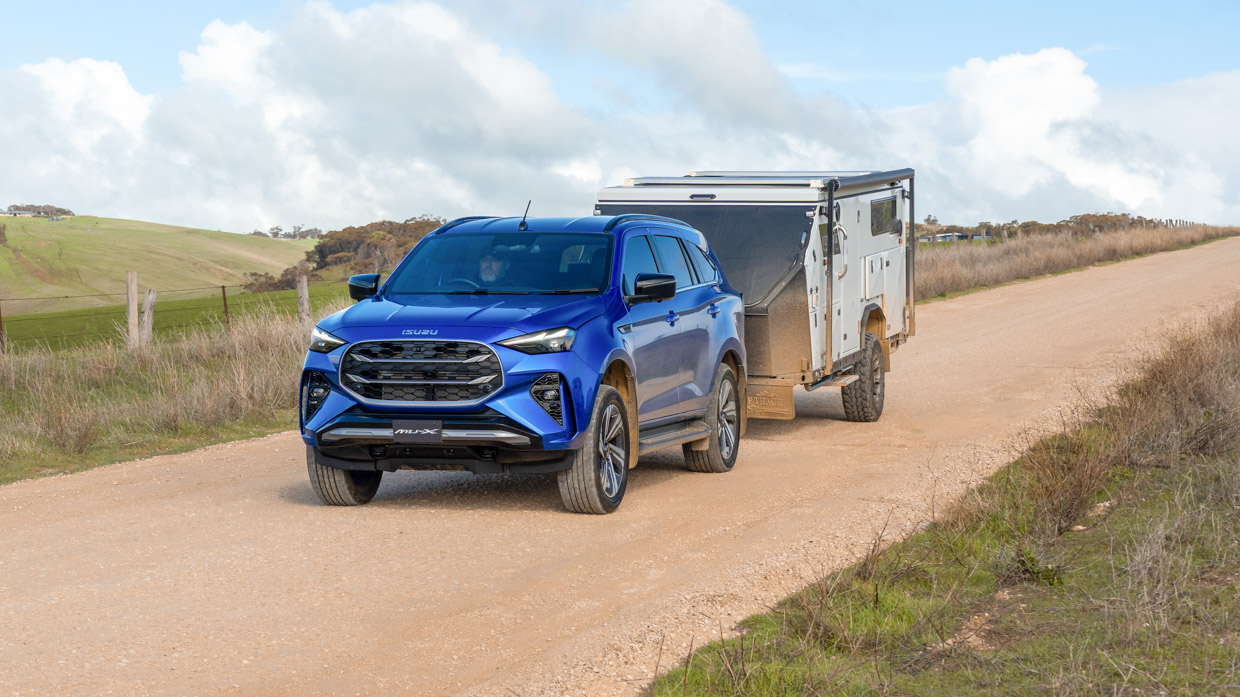
Commercial vehicles such as utes and ladder-frame SUVs towing over 3000kg (like the MU-X) enjoy slight concessions for now, but Isuzu’s at serious risk of being caught with its pants down.
If you offer only diesel engines and have no electrified models like hybrid, plug-in or EV to help write off your CO2 crimes (as rivals Toyota, Ford and BYD do), financial penalties will build, and there’ll be little choice but to pass that cost on to customers.
Isuzu’s action begins now. While the Japanese brand still has nothing to confirm on the electrified front (although its D-Max EV soon goes on sale in right-hand-drive UK), a new 2.2-litre diesel engine with an eight-speed auto gearbox for the D-Max and MU-X has arrived to lessen the NVES punishment. And that’s what we’re testing here.

It’s incredibly important the market takes to this new diesel donk. Pollution fines are directly tied to CO2 g/km numbers, so the more Isuzu sells with lower numbers, the less its financial penalty.
Isuzu’s fleet-special 1.9-litre engine has been dumped to make way for this new 2.2-litre, which offers from 6.6L/100km economy and 174g/km in a 4×4 D-Max.
That old 1.9 gave 6.9L/100km and 180g/km so there are marginal gains there, but arguably just as important, this new engine boosts appeal as 2.2-litres sounds less weedy than a motor displacement starting with the number ‘1’.
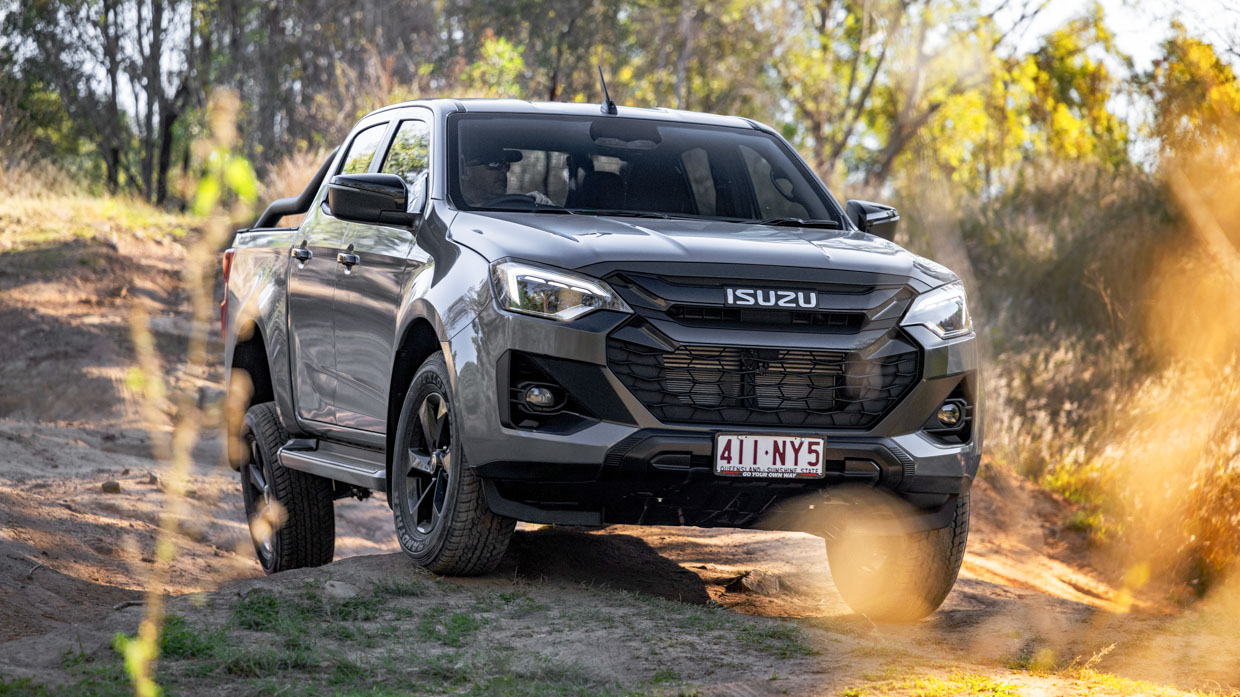
Thing is, Isuzu’s success has been based on its stalwart truck-sourced 3.0-litre four-cylinder turbo-diesel. Buyers would flock to it for its large displacement easy power, towing clout and solid reliability, and for some, an Isuzu without a 3.0L is like a front-engined Porsche 911… it just doesn’t seem right.
But to help it out of a tricky NVES hole, there’s a palpable sense Isuzu must entice buyers – fleet and private – into picking the 2.2L to bring down overall CO2 numbers. But key question for those considering a 120kW/400Nm downgrade from the 3.0L’s 140kW/450Nm, is the juice worth the 800cc squeeze?
It’s certainly a welcome boost over the old 1.9L’s 110kW/350Nm, and while we’re drinking at the positives fountain, a 2.2L variant versus the equivalent 3.0L is cheaper to buy, cheaper to run, its rated to tow the same 3500kg (the 1.9L only handled 3000kg), and you get a new eight-speed auto transmission (all manuals are now gone), while the bigger engine soldiers on with two cogs less.
The new eight-speed isn’t destined for the 3.0L, we’re told.

Prices? Typical of Isuzu, there’s a lengthy grade walk, and equally typical it offers drive-away pricing on select models which makes the rest of the line-up look over-priced.
Cheapest 2.2L D-Max is a 4×2 SX single cab for $36,990 on the road, while the 2.2L range topper D-Max 4×4 X-Rider Crew is $56,990 drive-away, despite a $59,500 RRP. Daft, we know.
Meanwhile, a 2.2L MU-X 4×2 LS-M is $48,990 drive-away, then the highest grade 2.2L MU-X 4×4 LS-T is $69,990 drive-away – both also below their RRP.
For comparison, these 2.2L variants are $2000 cheaper than the same grade 3.0L-equipped examples.
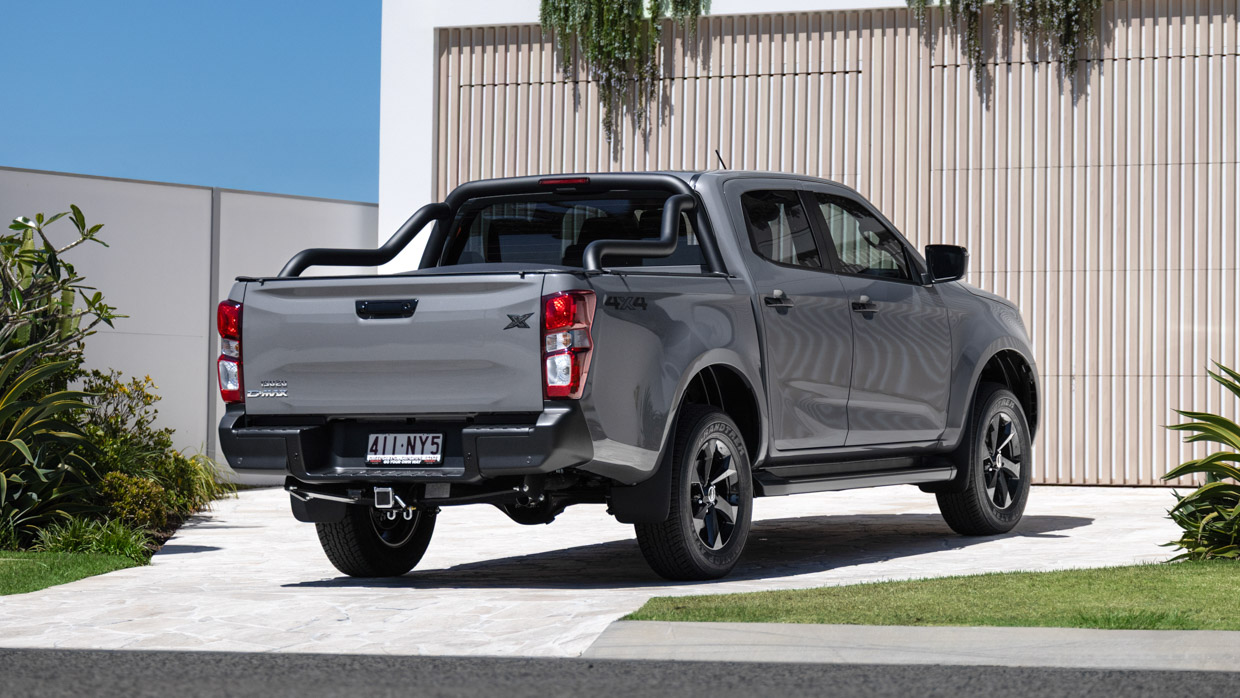
Here’s the full price list for the 2.2L and 3.0L line-up:
2.2L & 3.0L D-Max and MU-X Pricing (RRP before on-road costs):
D-Max
- 4 x 2 Single Cab Chassis SX 2.2L AT $36,200 ($36,990 drive-away)
- 4 x 2 Single Cab Chassis SX 3.0L AT $38,200
- 4 x 2 Space Cab Chassis SX 3.0L AT $41,700
- 4 x 2 Crew Cab Chassis SX 2.2L AT $42,700
- 4 x 2 Crew Cab Chassis SX 3.0L AT $44,700
- 4 x 2 Crew ute SX 2.2L AT $44,200
- 4 x 2 Crew ute SX 3.0L AT $46,200
- 4 x 2 Crew ute LS-U 3.0L AT $57,000
- 4 x 4 Single Cab Chassis SX 3.0L AT $46,200
- 4 x 4 Space Cab Chassis SX 3.0L AT $49,700
- 4 x 4 Crew Cab Chassis SX 2.2L AT $50,700
- 4 x 4 Crew Cab Chassis SX 3.0L AT $52,700
- 4 x 4 Crew Cab Chassis SX 3.0L AT $53,200
- 4 x 4 Crew Cab Chassis LS-U 3.0L AT $63,500
- 4 x 4 Crew ute SX 2.2L AT $52,200
- 4 x 4 Crew ute SX 3.0L AT $54,200
- 4 x 4 Crew ute LS-M X-Rider 2.2L AT $59,500 ($56,990 drive-away)
- 4 x 4 Crew ute LS-M X-Rider 3.0L AT $61,500
- 4 x 4 Crew ute LS-U 3.0L AT $65,000
- 4 x 4 Crew ute LS-U+ 3.0L AT $68,000
- 4 x 4 Crew ute X-Terrain 3.0L AT $73,000 ($69,990 drive-away)
- 4 x 4 Crew ute Blade 3.0L AT $80,900 ($78,990 drive-away)

MU-X
- 4 x 2 LS-M 2.2L AT $49,900 ($48,990 drive-away)
- 4 x 4 LS-M 2.2L AT $55,900
- 4 x 4 LS-M 3.0L AT $57,900
- 4 x 4 LS-U 2.2L AT $62,900
- 4 x 4 LS-U 3.0L AT $64,900
- 4 x 4 LS-T 2.2L AT $71,400
- 4 x 4 LS-T 3.0L AT $73,400 ($69,990 drive-away)
- 4 x 4 X-Terrain 3.0L AT $77,100 ($75,990 drive-away)
At first try, the 2.2L appears a smart inbetweener. The old 1.9L suffered an image and guts crisis, while the 3.0L’s clout may be overkill for some users.
With a smart hat on, if you’re towing light loads, towing infrequently or not at all, the 2.2L makes solid sense. Especially so in the MU-X which, as a family seven-seater, may be used only for the school run or occasional adventurous weekend.
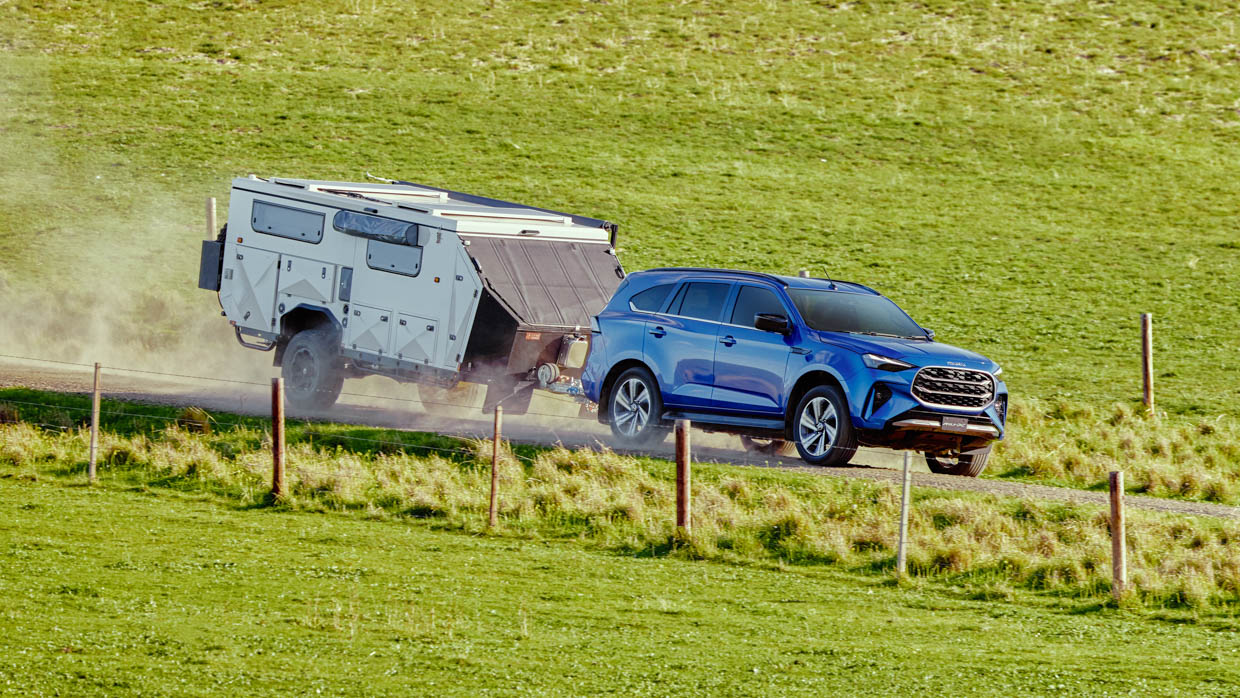
On the road, there’s the expected delayed response when first squeezing the throttle, but the 2.2L gives up solid torque from tiddly revs. The full 400Nm is there by 1600rpm, and you’re already gifted 255Nm at just above idle at 1000rpm… that’s a 60 per cent improvement over the old 1.9L.
It’s by no means a rapid engine, but where it shines is with an easy throttle, keeping revs in the torque sweet spot, and letting the eight-speed auto calmly go about its business. It’s all fairly slick, and unless you’re being heavy of shoe, the transmission’s barely noticed as it swaps cogs.
Same with the engine. In town and on the highway, the 2.2L shows no stress signs, and it feels barely different to the larger 3.0L. Pin the accelerator and it gets noisy and the gearbox a bit taken aback, but that’s hardly different to Isuzu’s larger motor.
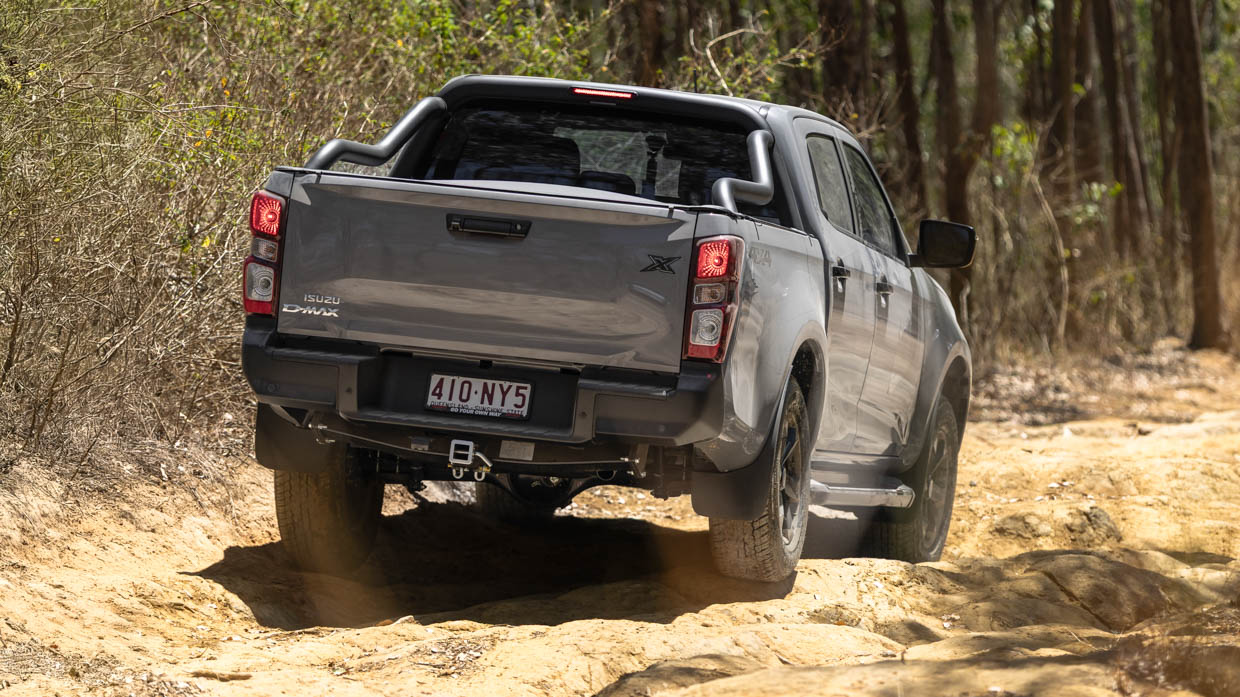
The engine must move an extra 100kg or so in the MU-X seven seater, and you feel that with each seat occupied, getting up to 110km/h won’t come quickly. Positively, the idle stop/start system is a decent one, firing the engine back up once you’re off the brake pedal or with a turn of the steering wheel. Even so, many users will just flick it off.
The D-Max is one of the better utes for ride comfort and control, especially with no load in the tub.
The X-Rider we tested features only three-leaf rear standard suspension (cab chassis models get heavy-duty three-leaf better suited to work trucks regularly carrying load) so it’s never too jiggly. But hop in the coil-sprung MU-X seven-seater and life is far comfier both on and off-road.
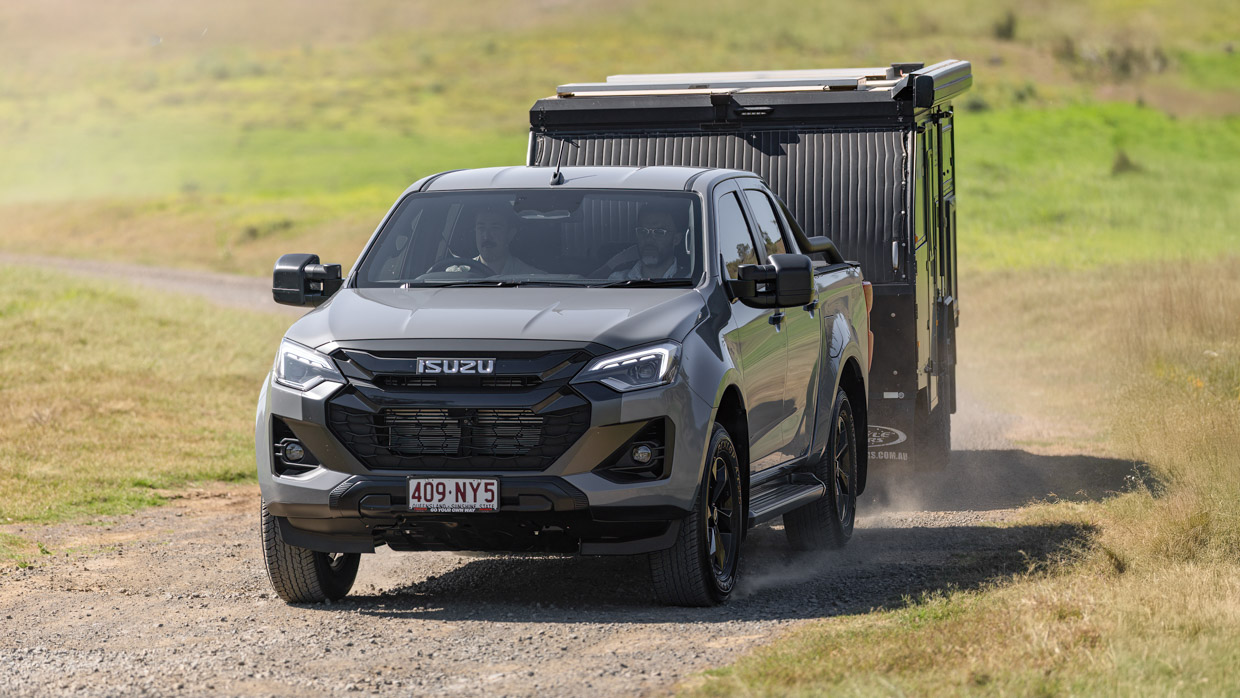
Next test was slinging a two-tonne caravan on the back of a 2.2L D-Max. The eight-speed ’box ensured the engine didn’t become a wail of flare, but it was clear the outright guts of a 3.0L was missing. Again, proper tow folk will still pick the larger displacement Isuzu motor.
Where the bigger Isuzu engine seemingly isn’t needed is for off-roading. We tackled a gnarly, dry dirt course with hefty holes, and as these 2.2-litre models still get the brand’s rear diff lock and impressive Rough Terrain Mode, both D-Max and MU-X performed their typical easy walk-over such obstacles.
Lumps of torque from low revs ensured very little throttle input was needed.
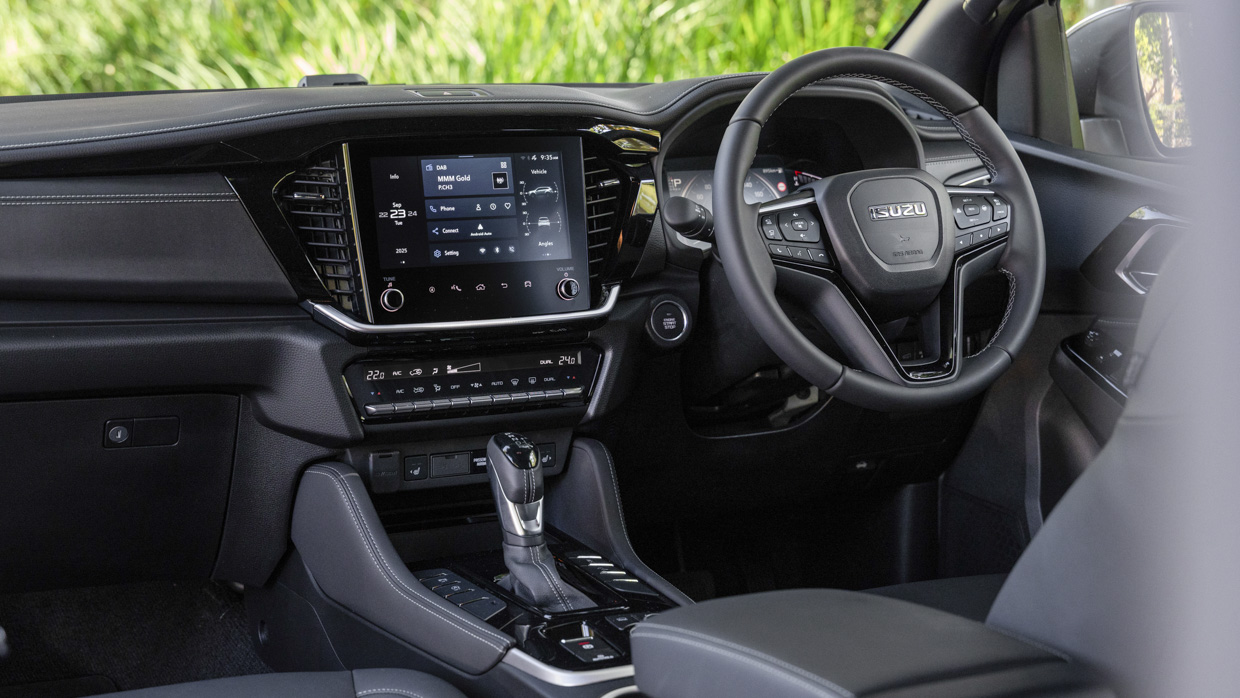
We’ve covered D-Max and MU-X drive and specs in other features which are worth a read, but it must be pointed out that the 2.2L D-Max models aren’t the plushest. If you want leather and more modern goodies, you must move into the likes of a 3.0L X-Terrain.
Showing (for now at least) these 2.2L D-Max models are aimed at fleets and those not dazzled by luxe, the range topper with this engine, the 4×4 X-Rider, still features very analogue climate control (no complaints there), a manual handbrake, metal key in the ignition and cloth seats.
There’s just two USB-C ports (one front, one rear), and while there’s wireless smartphone mirroring, there’s no wireless charging in the heavily plastic centre console.

The family-friendly MU-X 2.2L 4×4 LS-T is fancier. It scores leather-accented seats, leatherette for door trims and the centre console, power and heated front chairs, ambient lighting, 360-degree monitor and remote engine start.
So, do you pick this new 2.2L or the old 3.0L? It will absolutely depend on intended use, and in how high a regard you hold Isuzu’s big block four-cylinder.
Financially it’s a bit close for comfort. An extra $2000 for the 3.0L isn’t a big jump, but the 2.2L has the dangling carrot of a more modern eight-speed gearbox, and better economy. Example numbers are 6.6L/100km vs 7.1L/100km (D-Max 4×4) and 6.7L/100km vs 7.6L/100km (MU-X 4×4). Not to be sniffed at if you plan on doing a lot of kilometres.
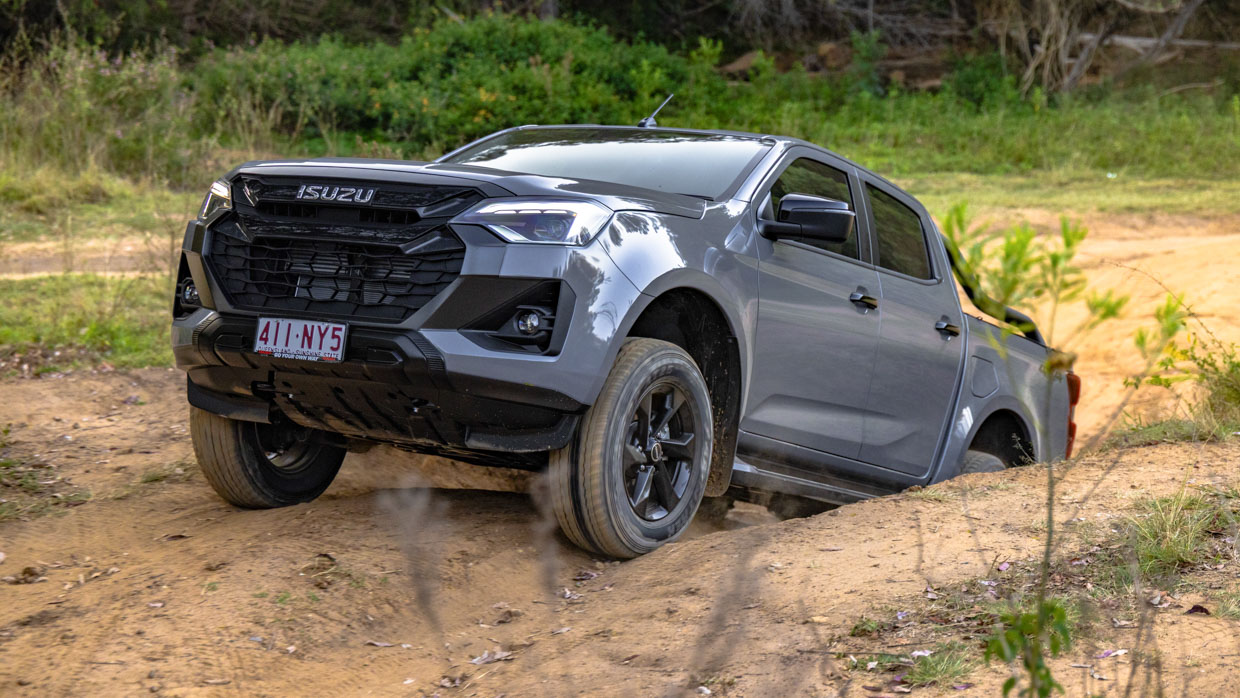
What may happen, as NVES fines increase, is greater financial penalty passed on to buyers of the 3.0L. Should that price difference move to, say, $4000 versus the 2.2L, the smaller engine looks way more appealing.
Those heavy towing should stick with the 3.0L for guts and known reliability, although the 2.2L being rated to 3500kg is impressive, and there’s a six-year warranty for peace of mind. Annual services are a reasonable $469 per visit for the first five years.
Isuzu buyers – and there are many of you – would be strongly advised to sample both engines. If the 2.2L feels like it offers enough for your use, on our first sample it appears a decent powertrain if your priority’s not mega power and torque numbers. It’s smooth and responsive and quiet unless really pushed. Our mixed test in the 4×4 X-Rider returned 8.3L/100km.

The 2.2L arguably makes most sense in the well-equipped MU-X LS-T seven-seater at under $70k on the road. But we can guess the 2.2L will ultimately find its way into higher grade D-Max utes too, broadening its appeal.
The great unknown is what comes next for Isuzu. Hybrid? Plug-in? Full EV? This 2.2L is only going to give brief respite against the ever-tightening grip of NVES, so the D-Max and MU-X line-up will likely look very different in the next couple of years.
BYD Sealion 7 Premium RWD 2026 review
2 weeks ago

Sharp pricing, generous specification, handsome styling and a few touches of genuine luxury have catapulted the Sealion 7 to success — but it isn’t perfect
Good points
- Attractive outside and in
- Appealing, conventional cabin
- Nippy, pleasant performance
- BYD steering is getting better
- Poised and involving handling
- Remarkably premium execution
Needs work
- Inefficient, especially on the highway
- Limited range despite big battery
- Out-of-sync ride quality
- Heavy wheels thump into bumps
- Noticeable road noise
- Hypersensitive lane-keep aid
You’d have to live under a rock to not have noticed the surge of BYD-branded vehicles present on Australian roads. The Xi’an, China-based marque only burst onto the Australian market in early 2022 but in the intervening years, BYD has sold more than 60,000 cars locally.
That skyward growth trajectory has frightened legacy manufacturers and contemporary rival Tesla alike, particularly when it was supercharged by this year’s Shark 6 plug-in hybrid (PHEV) ute launch which felt ‘right place, right time’.

The cars haven’t been perfect, though. BYD has found favour with Australians via appealing pricing, generous specification, reasonable quality and ‘okay’ dynamics. It’s a recipe this country has seen before with the entrance of Japanese, then Korean, then Chinese cars.
Middling ride and handling of the Atto 3 small SUV, Dolphin hatchback and Seal sedan that beat the Sealion 7 to market made us wonder if BYD’s most important battery electric (BEV) model would also seem a bit mediocre on the road, dulling our enthusiasm for its sharp pricing.
The good news is that BYD is listening and learning. Numerous attributes of the Sealion 7 including ride, steering feel and refinement, represent clear improvements over the Atto 3 and (closely related) Seal.
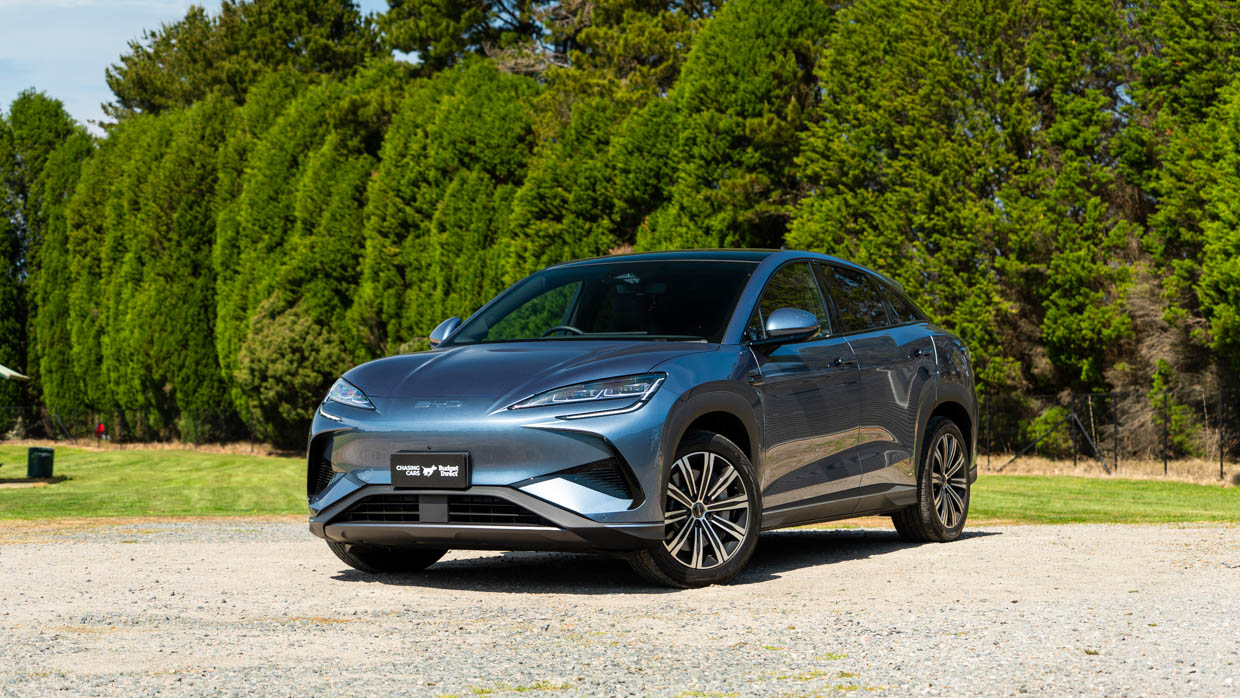
Not so surprising, then, that the Sealion 7 is the second-most popular EV in Australia for 2025 with 5183 deliveries to the end of July, well ahead of EV5 (3227). In some months, this BYD has bested the Model Y, though the Tesla SUV is still comfortably ahead in this year’s sales race (10,986).
What are the Sealion 7 Premium’s features and options for the price?
The Sealion 7 is a ‘big metal for the money’ proposition — a classic formula Australian families have been drawn to for decades.
The 4830mm-long Sealion 7 is on the generous side of the midsize SUV class, though it does compete closely with the marginally smaller Tesla Model Y (from $58,900 + ORCs), the Kia EV5 (from $56,770 + ORCs), and alternatives like the Volkswagen ID.4 (from $59,990 + ORCs).

Relevantly for the EV age, Sealion 7 is also a ‘big battery for the money’ pitch: its 82.5kWh (usable) lithium iron phosphate (LFP) unit is a larger pack than that Tesla, Kia or Volkswagen offer at this price.
Still, a big battery is only useful if meaningful range can be extracted from it. More on that later. For now, the nominally entry-level Sealion 7 Premium on test compares favourably on purchase price to key rivals.
While BYD may choose to add an even more affordable base model in future with fewer trimmings, the present range-opener (the $54,990 Premium RWD) is very generously specified, and few would truly need the dual-motor Performance AWD ($63,990 + ORCs).
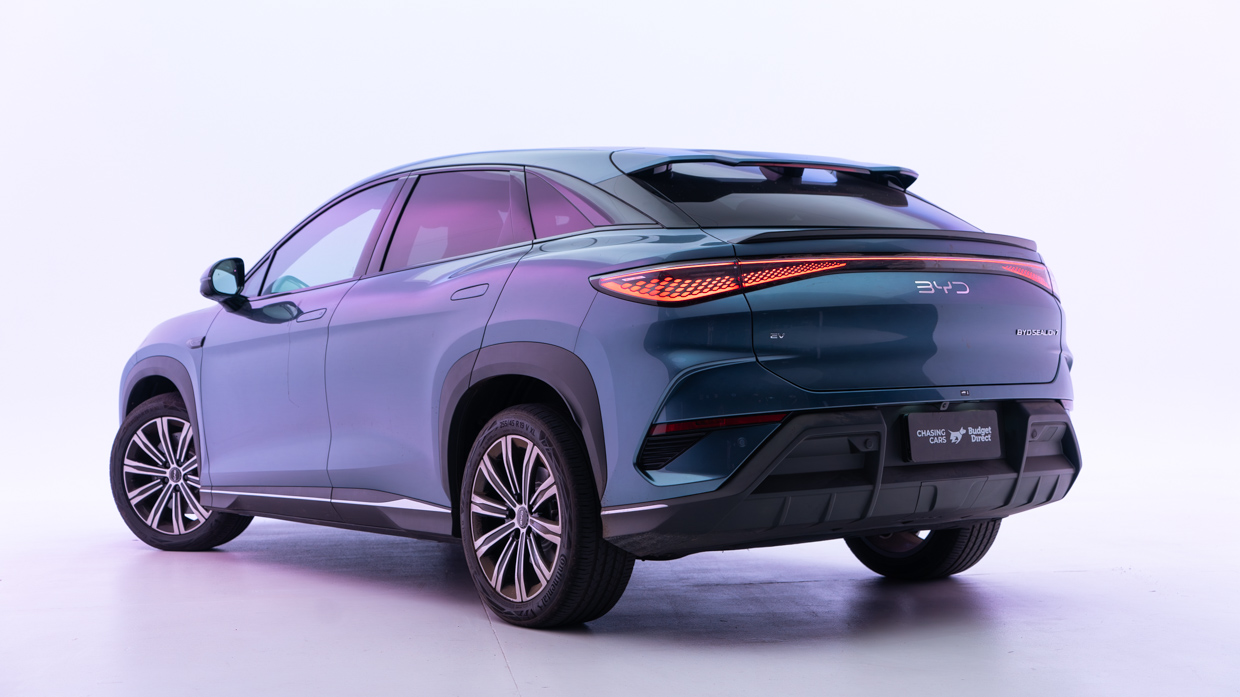
Standard specification for the Premium includes a 230kW/380Nm motor, 82.5kWh LFP Blade battery, 19-inch alloy wheels, auto LED headlights, a panoramic sunroof (non-opening), power tailgate, double-glazed acoustic glass, and a Type 2 charging cable.
Inside, included kit takes in genuine leather steering wheel and seating (with heating/cooling for the first row, and heating for the second), a 12-way power driver’s seat with memory and massage, six-way power passenger seat, and a 15.6-inch rotating touchscreen (with navigation plus wireless Apple CarPlay/Android Auto).
Further equipment includes four USB ports (two front, two rear), one wireless device charger, dual-zone climate control (with heat pump and rear air vents), 12-speaker Dynaudio stereo, and online connectivity with a digital key and over-the-air updating function.
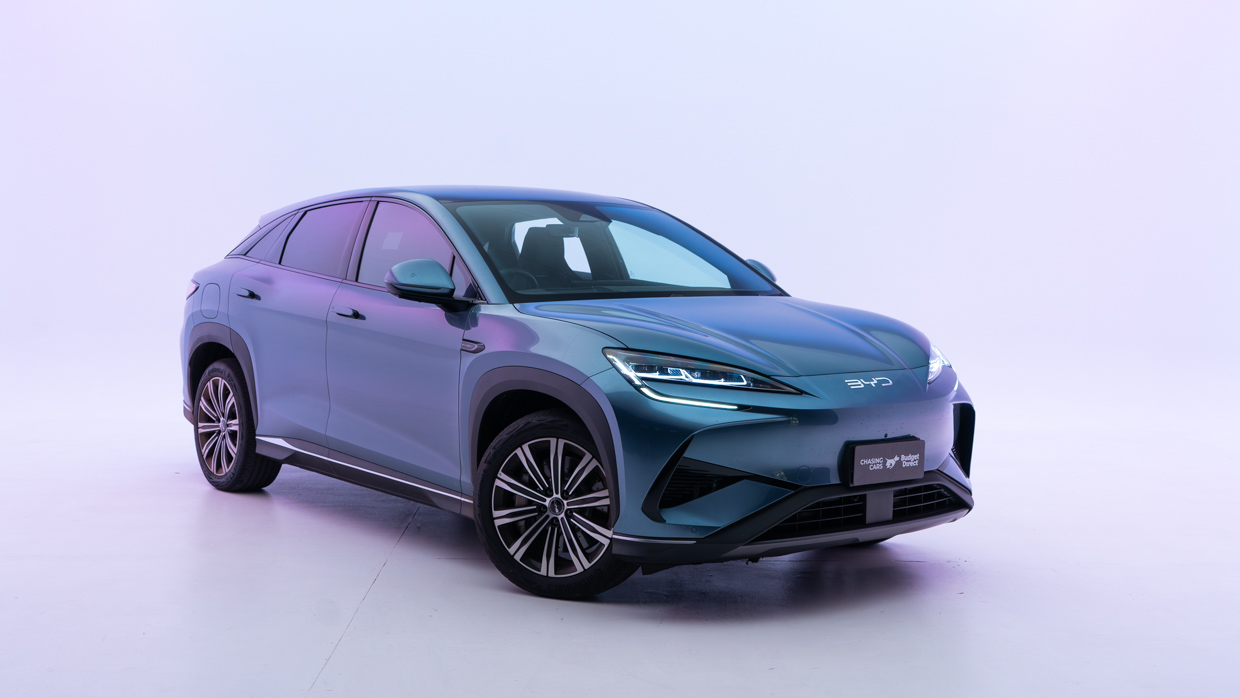
Fair to say the Sealion 7 Premium is well equipped for a base model!
An additional $9000 mainly buys a lot more speed, with the Performance trim gaining an additional (front) 160kW/310Nm motor for 390kW/690Nm combined outputs, plus painted front brake callipers and a heated steering wheel.
With black leather the only interior colour, extra-cost options are limited to exterior colour. Aurora White is standard, with Cosmos Black and Atlantis Grey attracting a $1500 charge while Shark Grey is $2000.
How does the Sealion 7 Premium drive?
It’s great to see BYD absorbing feedback from owners and road testers alike and improving new releases. While the Sealion 7 uses the same ‘ePlatform 3.0’ modular architecture that also underpins the Dolphin, Atto 3 and Seal, this SUV has a range of improvements.
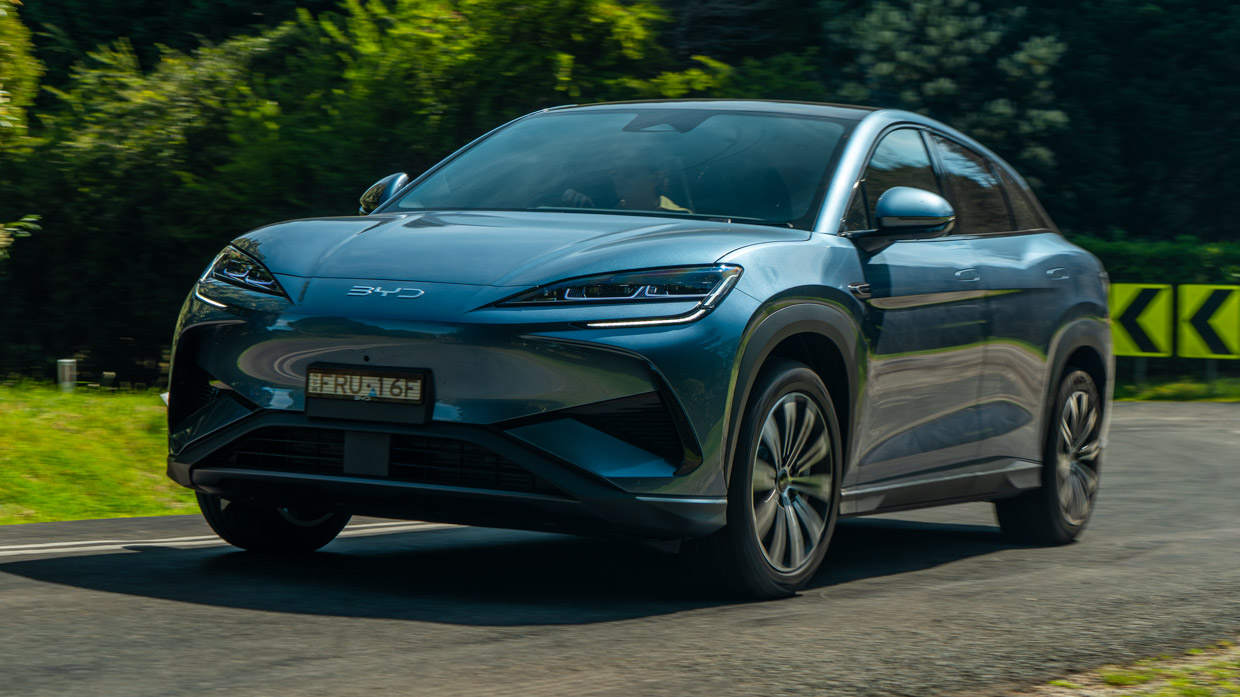
On the road, the simpler Sealion 7 Premium feels the most natural, with its single rear motor (producing 230kW/380Nm) imbuing it with surprisingly nippy performance at all legal speeds. You’d even call it fleet-footed.
By contrast the 390kW/690Nm Performance is a touch overpowered on this chassis.
Also to its credit is the (relatively) lighter weight of the Premium — though at 2225kg, it’s quite porky for this class (the ID.4 is 2154kg and the Model Y is as light as 1921kg). The Performance is heftier at 2340kg; the culprit is the big 82.5kWh battery, burdened by the heavier weight associated with LFP chemistry.
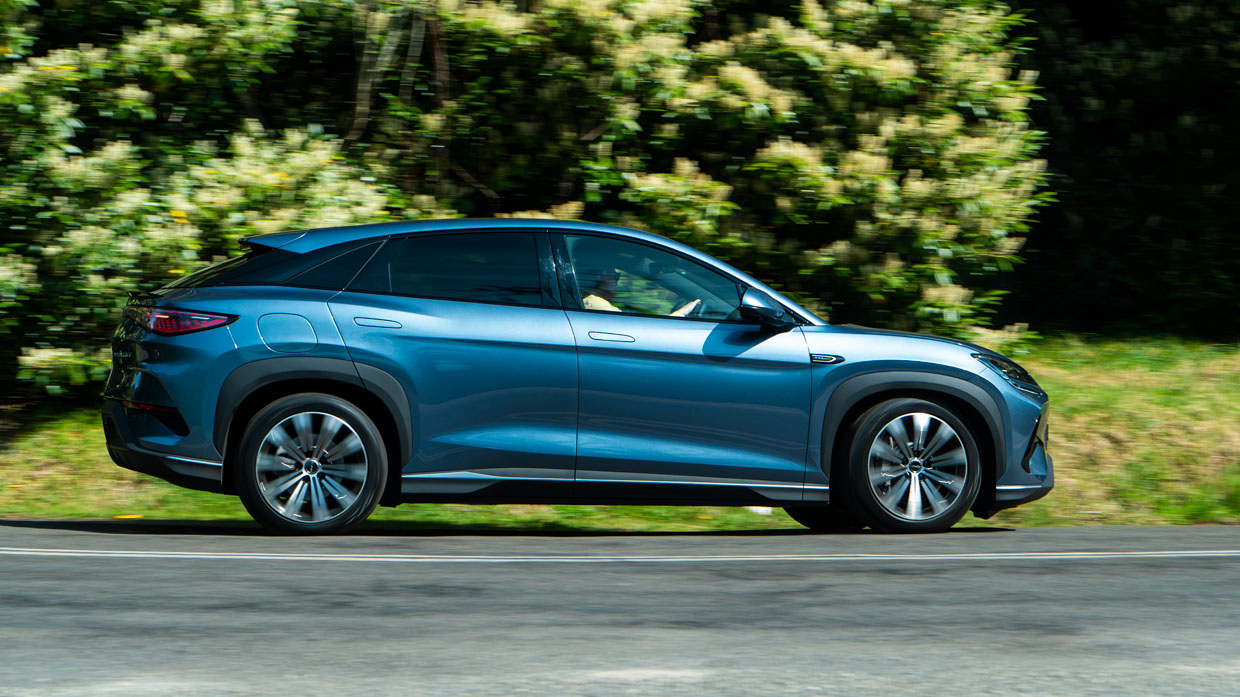
The main vice to the way the Sealion 7 its feeling of heft. It feels like it has a lot of unsprung weight (even on the Premium’s 235/50 R19 front or 255/45 R19 wheels and tyres) and as a result, the wheels clunk into potholes with a thud.
That effect is common for EVs, which need big wheels and tyres to support their weight and pace.
More frustrating is the Sealion 7’s disjointed ride quality. It might have quality frequency selective dampers all-round, but the settings aren’t right. The front suspension feels a touch overdamped, stiffly rebounding from expansion joints, while the rear is underdamped with body control suffering and producing head toss.

This is fixable, and BYD should bother to do so because the Sealion 7’s core chassis dynamics are solid, and it is clear a lot of work has gone into refining suspension geometry. This has produced a surprisingly engaging handler: the big BYD has nice cornering posture and is very confident in the bends.
On a twisting road, the Sealion 7 is more fun to drive than a Model Y with slightly more relaxed electronic stability control tuning and also a more natural-feeling steering rack—what a nice improvement from the weirdly grainy steering of the BYD Seal and Atto 3!
Adjustable regen settings make it possible to find a comfortable level of off-throttle deceleration though the physical brake pedal started to get ‘long’ after burning up and down a few B-roads.
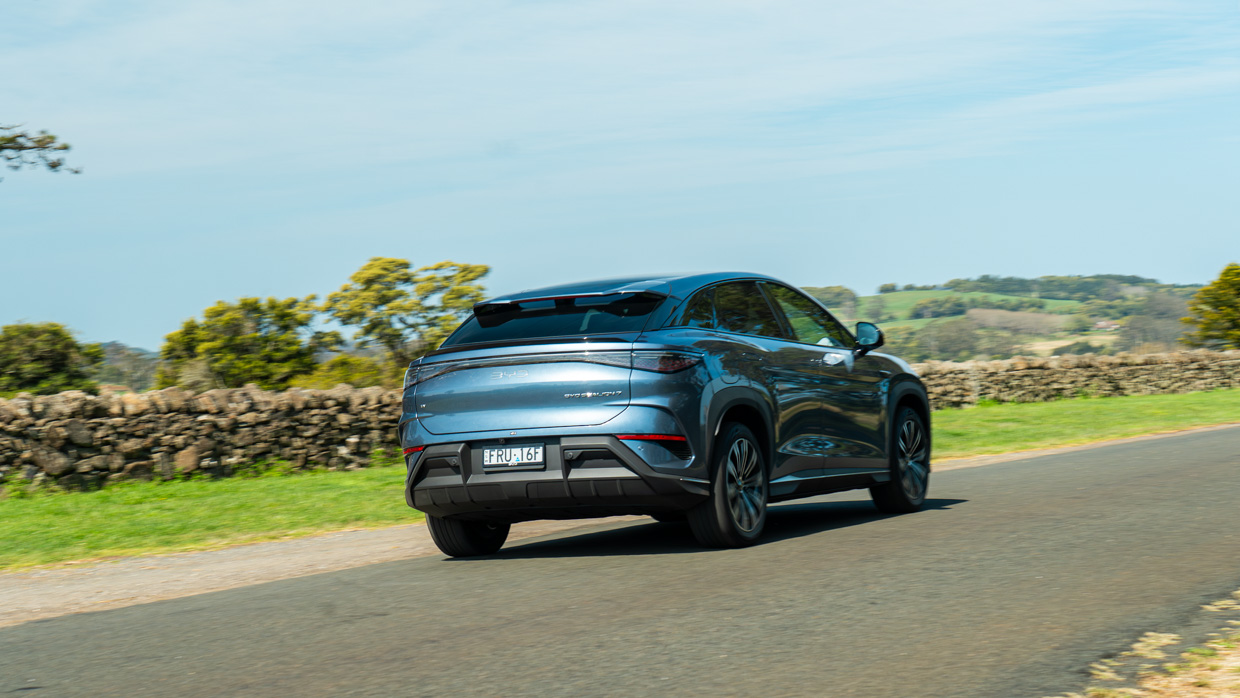
Cabin refinement is a mixed bag. The Sealion 7 has double glazing on the windscreen and front windows, and as a result, there is little wind or environmental noise — but there is pronounced and distracting road noise, especially on coarse chip.
What is the Sealion 7 Premium’s interior and tech like?
While the driving dynamics are ‘getting there’, where the Sealion 7 really makes an impact is inside. Beyond the pleasant external kerb appeal, the interior feels (and is) lush. Build quality seems reasonable enough while the materials used are genuinely appealing.

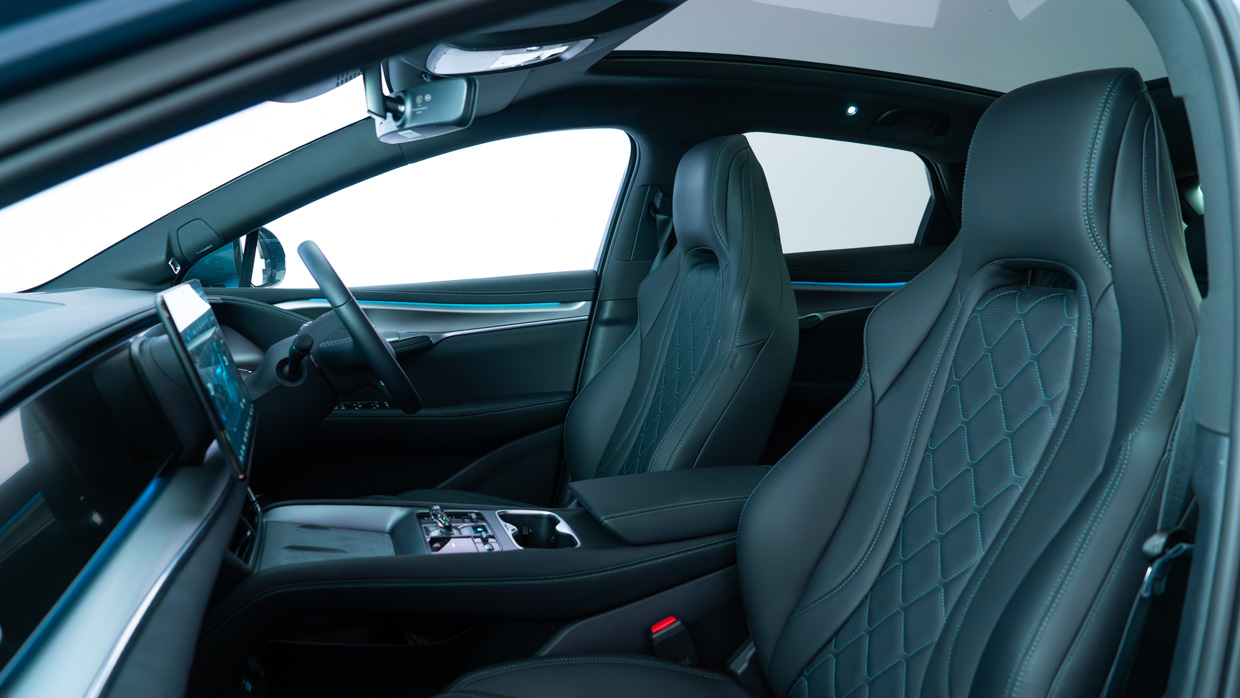
We say ‘genuine’ because that’s what it is: unlike so many vinyl-clad rivals, the upholstery on the seats and steering wheel is actual leather in the Sealion, and it feels it. Black is the only colour but the cabin of the Premium feels rich and a step above the plasticky meanness of far too many cars in 2025.
In that sense, it’s almost as if BYD is pitching itself as a Lexus-like premium marque. The truth is that in China, BYD sells models with various levels of plushness, with the Seal sedan and Sealion 7 hailing from an upmarket vein but beneath Denza, BYD’s luxury brand that is coming to Australia with its own range of models.
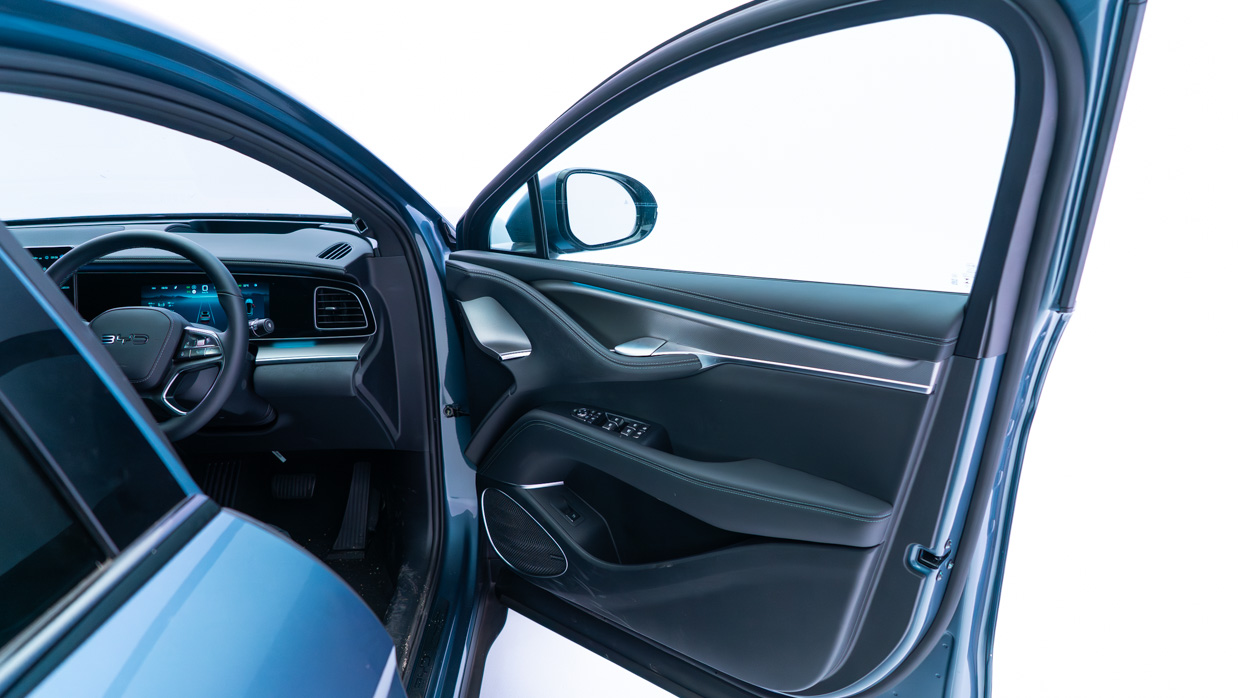

It’s not the last word in perceived expense but the Sealion 7 feels nice, not just on first glance but also over a longer drive where the smattering of soft-touch materials makes this SUV feel more expensive than its $55K price.
We found the driver’s seat comfortable and appreciated the standard-fit seat cooling (very much needed in a dark leather interior in the Australian summer). However, we’re less enamoured by skimping on passenger lumbar, noted when our co-driver started squirming.
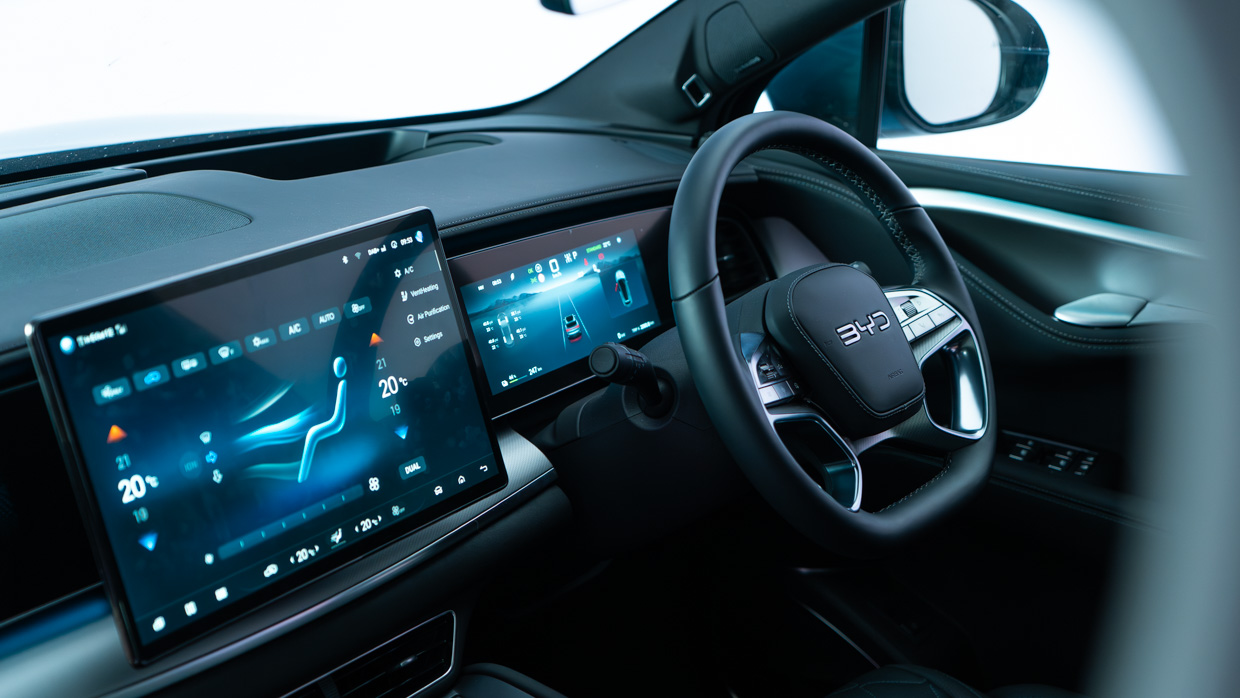
No doubt another factor that appeals to some buyers cross shopping the BYD against a Tesla is the Sealion 7’s conventional cabin layout. Clear driver (10.25-inch) and central (15.6-inch) screens are present here and they do, well, what you would expect for the most part. The middle one even rotates — a cool gimmick.
There are even some physical buttons here and there for functions like volume and drive mode but we’d prefer to see real climate controls used in future, particularly as the (stable) wireless CarPlay/Android Auto connections take over the entire screen, including the software air-con control.
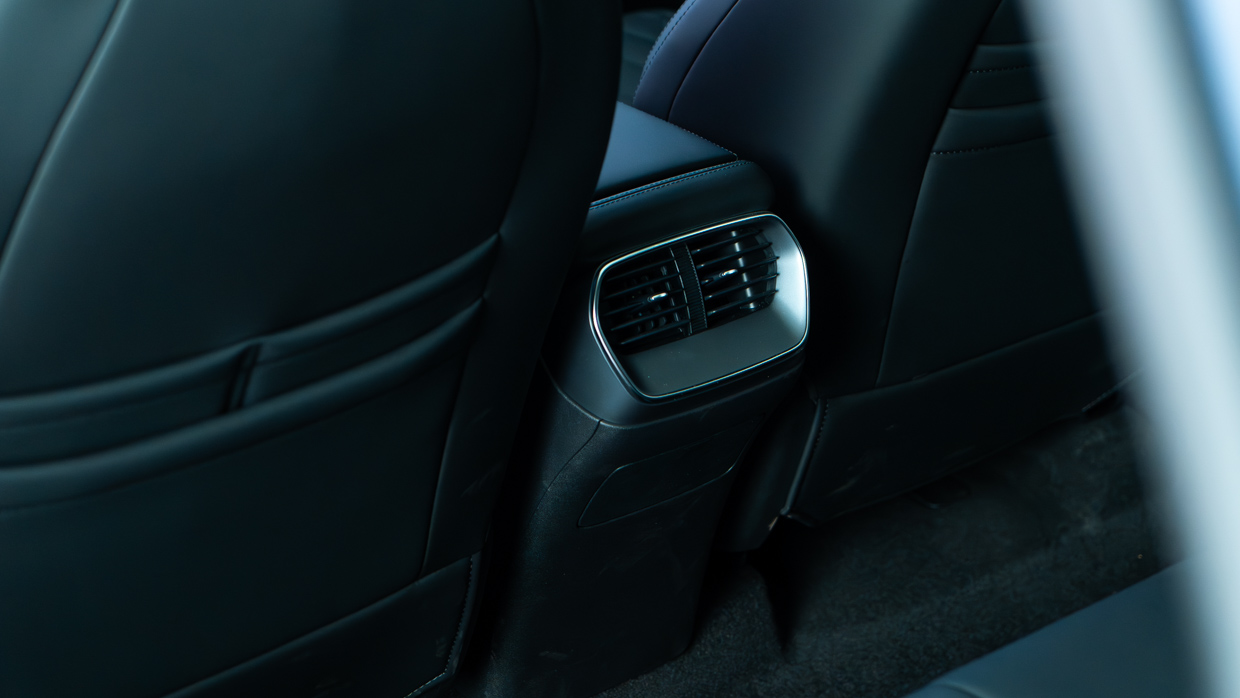

The Sealion 7’s relatively long 2930mm wheelbase affords plenty of back seat room, with at least two adults comfortably sliding into the second row while the tighter centre pew means infrequent five-up transport is possible. Rear air vents are standard.
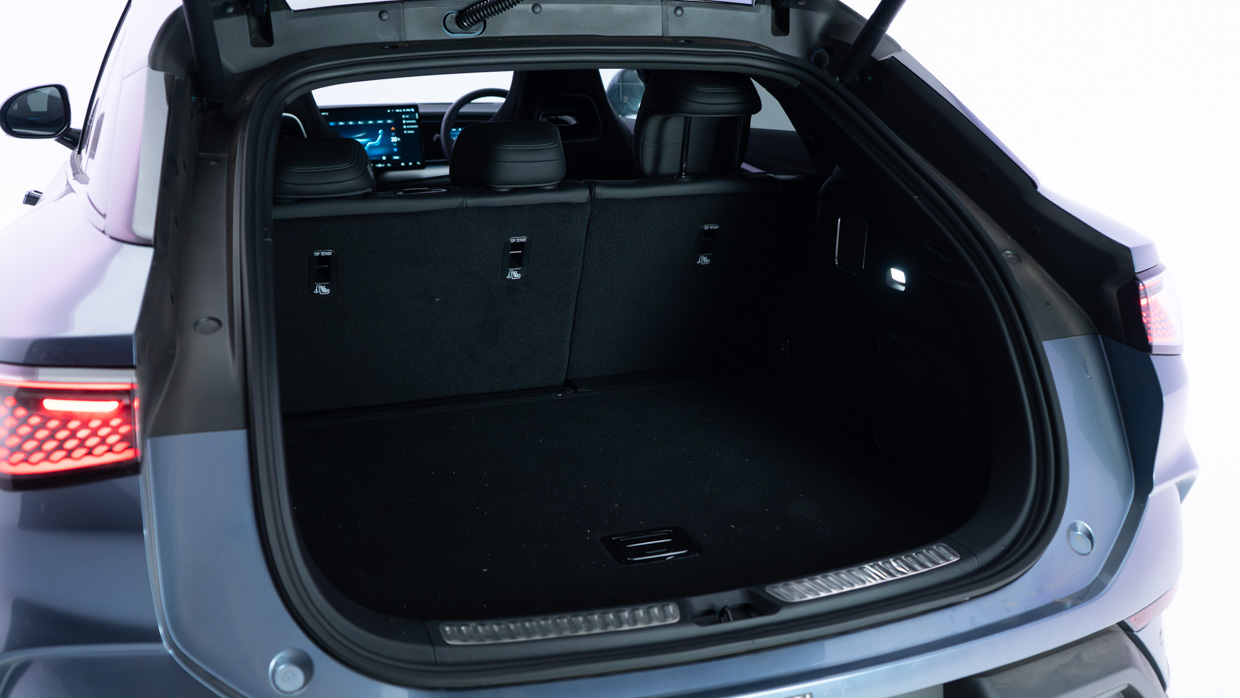
A power tailgate opens promptly to reveal a reasonable 500 litres of boot space. The boot itself is a little shallow but it’s wide and sliding suitcases in is simple enough. Like most EVs, there is no spare wheel or tyre but instead a tyre repair kit.
Is the Sealion 7 Premium a safe car?
Yes. The BYD Sealion 7 received a five-star score from Australia’s vehicle safety and crash testing body ANCAP against tough current 2025 standards.
The Sealion 7 was crash tested in Europe by Euro NCAP, with ANCAP receiving those scores and ‘translating’ them into the Australian protocol.

Individual scores recorded by the Sealion 7 were as follows:
- Adult occupant protection: 87 percent
- Child occupant protection: 93 percent
- Vulnerable road user (pedestrian/cyclist) protection: 76 percent
- Safety assist technologies: 78 percent
All available safety features are standard across the Sealion 7 range with no ‘extras’ reserved for more expensive models. These standard technologies include:
- Autonomous emergency braking (front, junction, rear and backover)
- Front and rear cross traffic alert with braking function
- Adaptive cruise control
- Lane keeping assistance
- Blind spot monitoring
- Traffic sign recognition
- Driver attention warning
- 360-degree parking camera
- Child presence detection
We were impressed by the smoothness of the Sealion 7’s adaptive cruise control and the clarity of its 360-degree camera (particularly as the latter is presented on such a huge 15-inch screen). Parking is made easier by this.

However, the lane keeping assistance is hypersensitive when intelligent/adaptive cruise control is engaged. Cruise control can be changed to manual (which reduces the lane intervention) but this can’t be done on the fly — the Sealion 7 has to be parked.
Additionally, the driver attention monitor was oversensitive, though this can be switched off via the menus (however, it reverts to ‘on’ every time the car is driven).
What are the Sealion 7 Premium’s ownership costs?
The warranty that applies to the Sealion 7 runs for six years/150,000km in the case of the vehicle, or eight years/160,000km in terms of the traction battery. The latter warranty promises at least 70 percent battery capacity retention.
At current prices, servicing costs for the Sealion 7 Premium are $1543 for five years/100,000km, with maintenance intervals taking place every 12 months/20,000km. Each visit averages a reasonably affordable $309.
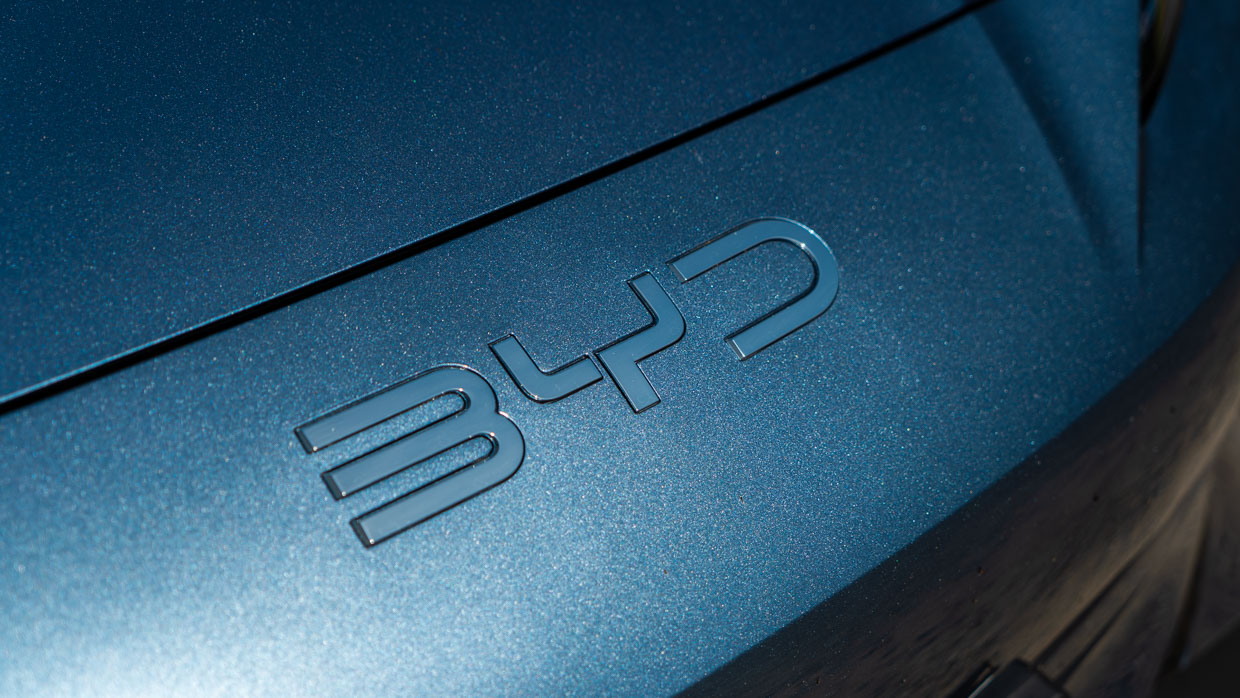
Both versions of the Sealion 7 sold in Australia use an 82.5kWh (usable) LFP battery.
To judge the Sealion 7 Premium’s efficiency, we conducted range tests on urban roads and on Australian highways. The urban test was conducted in Sydney in moderate traffic (average 30km/h) and the highway test was conducted between Sydney and Bowral return (uphill and downhill, averaging 100km/h).
These range tests resulted in the following outcomes:
- Sealion 7 RWD urban range test: 18.4kWh/100km efficiency (448km range)
- Sealion 7 RWD highway range test: 21.5kWh/100km efficiency (383km range)
Those scores mean that the Sealion 7 Premium is not particularly efficient. In similar range tests, the 2025 update to the Tesla Model Y Long Range RWD consumed 13.8kWh/100km (urban) and 16.0kWh/100km (highway).

At an indicative energy cost of $0.50/kWh, and with 10 percent charging losses factored in, every 100km driven in the Sealion 7 costs about $10 in urban areas and $12 on the highway (in charging costs).
Charging can be done at up to 150kW DC (claimed 32 minutes 10-80 percent) and 11kW AC (claimed 9 hours 0-100 percent). Vehicle-to-load (using the Sealion 7’s battery to power external appliances) is possible at up to 3.3kW speeds.
The honest verdict on the Sealion 7 Premium
At a price of $54,990 + ORCs, the BYD Sealion 7 Premium is one of the best-value new cars on the Australian market.
This SUV is generously proportioned, big enough for family duties, handsome outside, and quite richly appointed inside. It is quick, quite refined and reasonably competent to drive on Australian roads. Certainly, it does enough to feel well-executed.
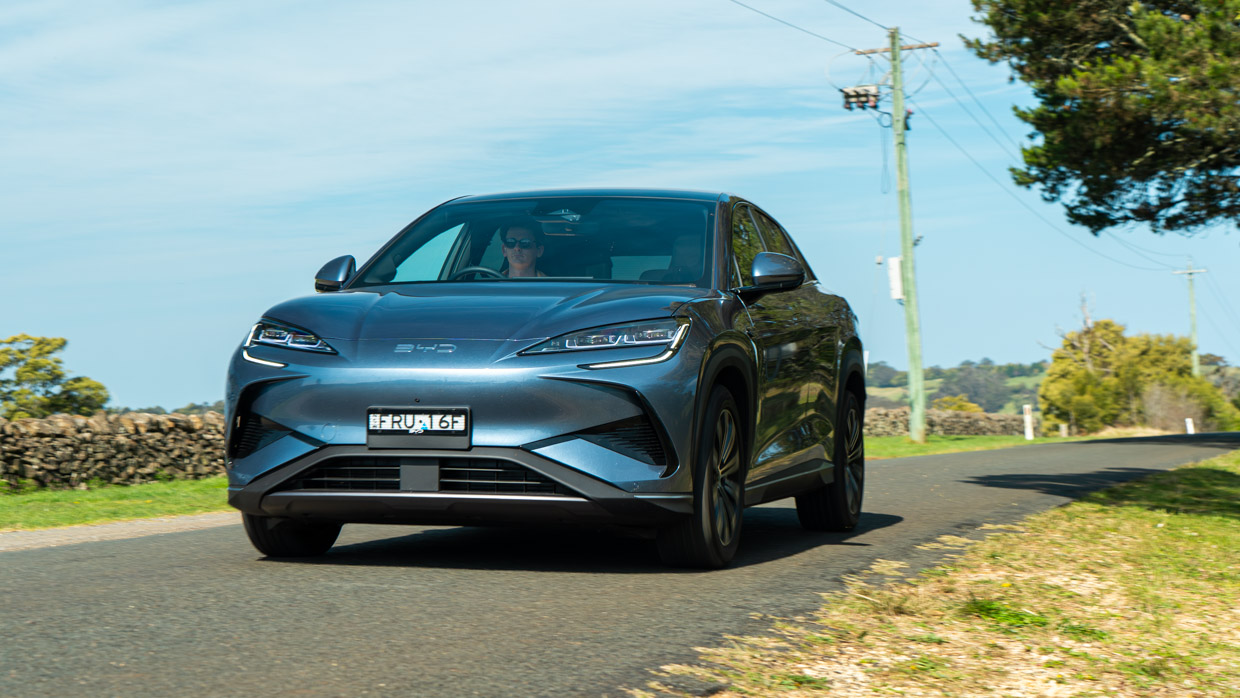
The Tesla Model Y is better to drive and considerably more energy efficient (and is therefore cheaper to run), but we appreciate the Model Y is a ‘vegemite’ style choice: you’ll hate it or love it. The Sealion 7 is considerably more mainstream in its approach.
More attention to efficiency and ride quality would further bolster the Sealion 7’s broad appeal, and we’re hopeful to see these aspects improved in a future update.
GWM Haval H6 PHEV 2026 review: Australian first drive
2 weeks ago

Convincing Australian shock absorber and steering tune combine with slick new plug-in hybrid powertrain to make top-end H6 the best GWM effort yet
Good points
- Two powerful PHEV options added
- Aussie tuning improves steering and ride
- Affordably priced, versus rivals
- Spacious, well-kitted cabin
Needs work
- Australian tune not in showrooms yet
- Some poor cabin ergonomics
- Only PHEV nabs new touchscreen
- AWD versions pricey by Haval standards
It isn’t so much that Chinese manufacturer GWM has decided to get serious. That decision was made more than a year ago. However, the consequences of a call to take the fight directly to Toyota is now bearing fruit — with the first arrival the 2026 Haval H6.
But wasn’t the H6 only just facelifted? Well, yes, but the timing was off. While they wore altered external/internal styling, the 2025 facelift of the H6 predated two major changes held back for 2026. As such, we’d hold off on any purchase until then.

Early next year, H6 units rolling into GWM showrooms won’t just offer a new top-end powertrain (a turbo-petrol plug-in hybrid with about 90km range), but even more importantly, overhauled suspension and steering retuned by ex-Holden dynamicists right here in Australia.
In support of the efforts of those engineers, led by VE/VF Commodore ride and handling guru Rob Trubiani, GWM has leased Holden’s old Lang Lang Proving Ground and is in fact now trying to purchase that facility, enticed by its uncanny recreation of Australia’s road quality.
Chasing Cars travelled to Lang Lang to test the upgrades to the H6 within the Proving Ground and on the dual-carriageway and meandering, fast country roads that surround it. This meant digesting both the new PHEV powertrain and the Trubiani tune of the electric power steering and shock absorbers — codenamed AT1 — all at once.
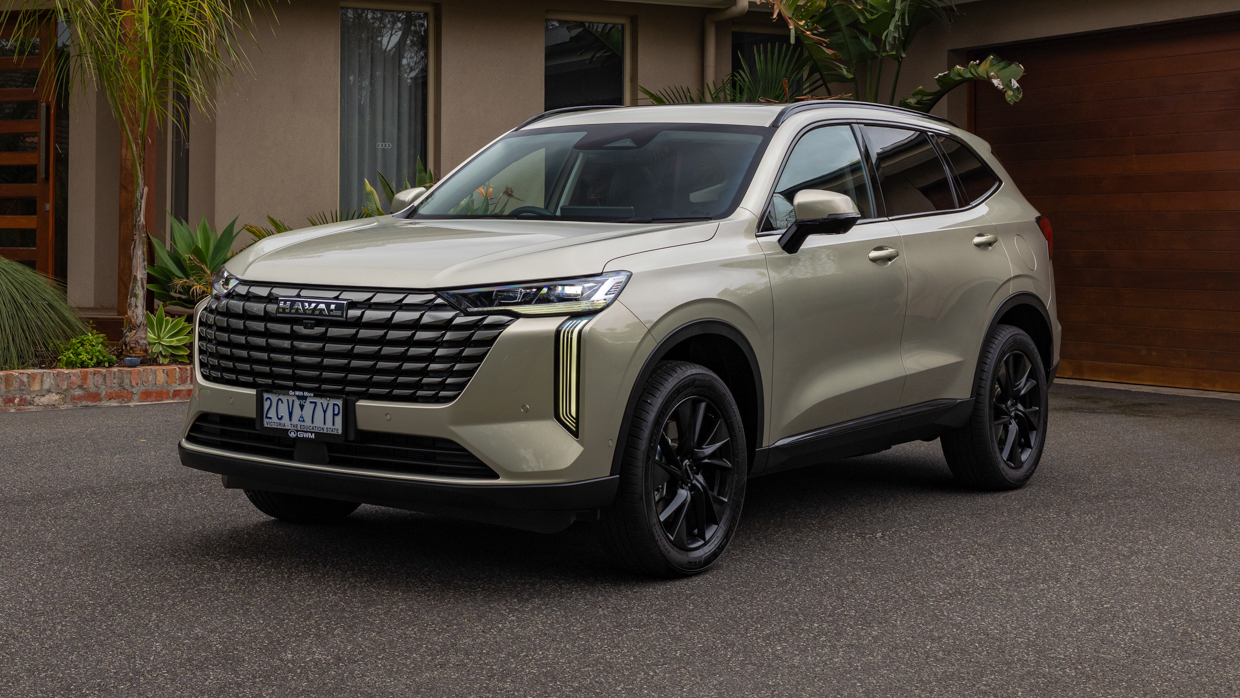
At least at first, only plugless hybrid (HEV) and PHEV versions of the Haval H6 will score the overhauled ride/handling hardware and software, with the price-leading petrol-only versions (from $35,990 driveaway) left out in the cold. And with the retune being very noticeable indeed, we’d urge you to avoid them until they are upgraded.
That means the gateway into the upgraded H6 will be the Lux HEV grade ($38,990 driveaway), with plug-in power a $4000 upcharge.
Both the HEV and PHEV powertrains can be optioned with electrified dual-motor AWD — albeit only on high-end Ultra trim — adding considerably more power than front-wheel drive versions.

By the time you’re considering Ultra AWD versions, there is just a $1500 jump from HEV to PHEV — making the latter quite a bargain given it adds a much larger battery.
Interestingly, despite identical power outputs to the HEV AWD powertrain, GWM only markets the H6 PHEV AWD as one of its new-generation Hi4 ‘intelligent’ AWD models. That’s the version we spent most of our time in, priced at $48,990, driveaway.
Value across the range is strong when compared to key rivals, with even the $39k Lux HEV bundling 19-inch alloys, LED headlights, roof rails, dual-zone climate control with rear air vents, vinyl upholstery, a power driver’s seat, 14.6-inch touchscreen, wireless device charger, eight-speaker stereo, keyless entry and wireless CarPlay/Android Auto.
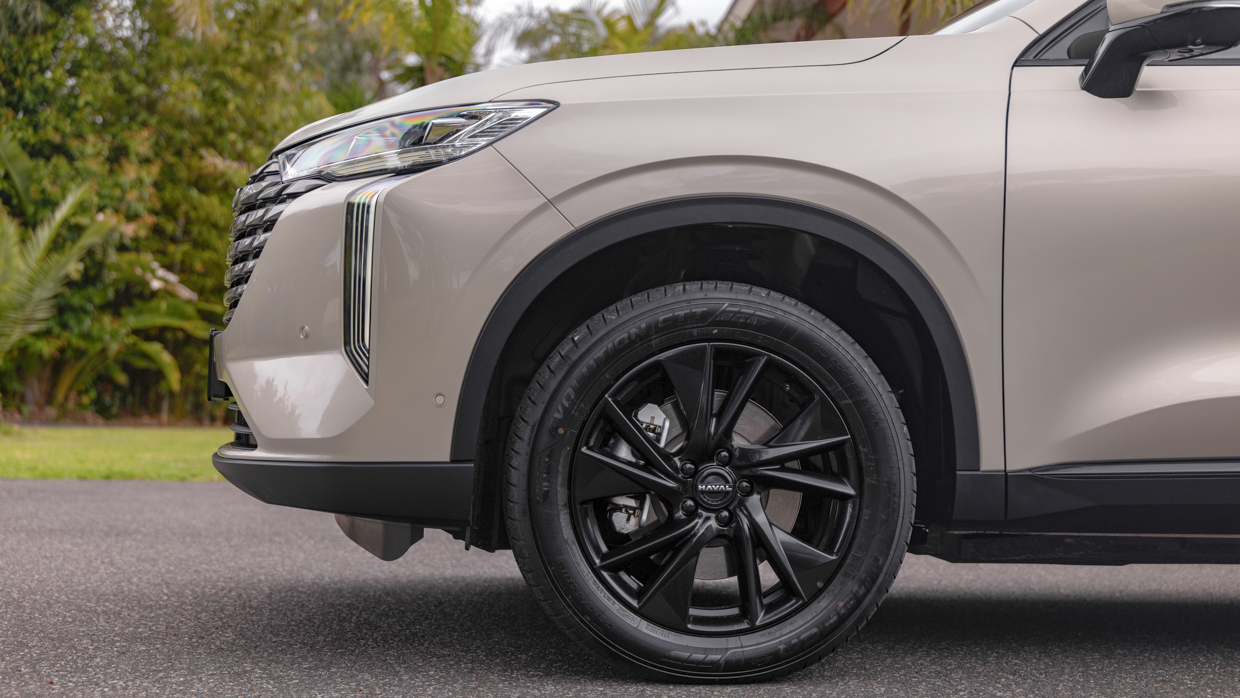
Still, we think it’s worth spending $3000 more for the Ultra grade, which adds conveniences like heated/cooled seats (you’ll want this on vinyl trim), a panoramic opening sunroof, head-up display, driver’s lumbar and memory, automated parking with front sensors, rear privacy glass and a head-up display.
PHEV versions step back from nine to eight speakers due to packaging issues, but the plug-in models uniquely gain GWM’s meaningfully quicker Coffee OS 3 infotainment system, a different steering wheel, connected car/telematics tech, and EV drive modes.
How does the H6 PHEV with Australian tune drive?
While the Haval doesn’t suddenly go to the top of the midsize SUV class, the degree of improvement to the H6 is deeply impressive — particularly when you consider it has only had about half a year of local development.
That’s what happens when you bring in the ‘big guns’: ride and handling engineers who know what they’re doing (thereby reducing the time it takes to get to an acceptable setting for the damper and steering tune), in a location where fast development work is achievable (like Lang Lang).
In our (pre-retune) H6 review published just two months ago, we remarked that the suspension was “overly stiff” and that the steering was “relatively loose” with “a tendency to understeer” before arguing that “we’d wait and see if the forthcoming changes make it a better car to drive.”
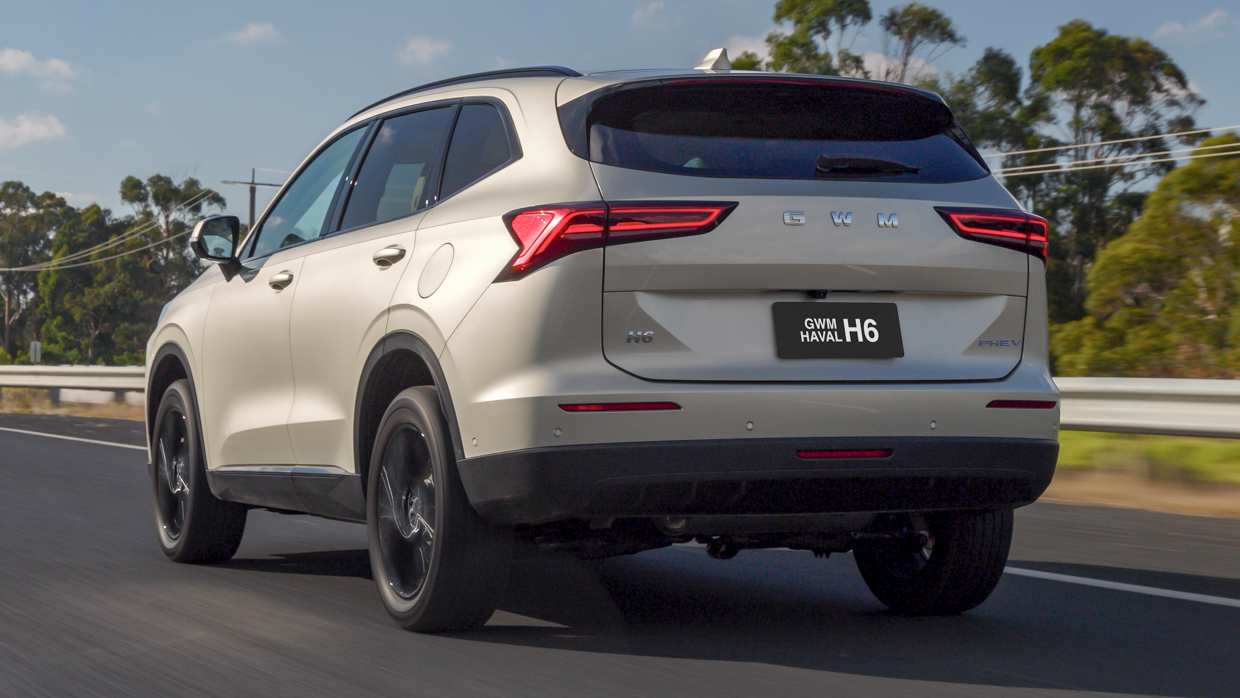
It didn’t take very long behind the wheel of the updated version (with the old one as a reference point) to notice three major upgrades.
The first two relate to the electric power steering, which has had its responses extensively altered across the rack range, but particularly in the area close to the centre. Pre-update, the H6 suffered from a huge dead spot on centre which has now been considerably reduced, with far more precise responses to small steering inputs.
Trubiani’s team has also tried (and mostly succeeded) to imbue the H6’s steering tune with the intuitive linearity of the VE and VF Commodore (the former having been benchmarked on the E39 BMW 5 Series). Doubling your steering input in the H6 now, more or less, generates double the response.
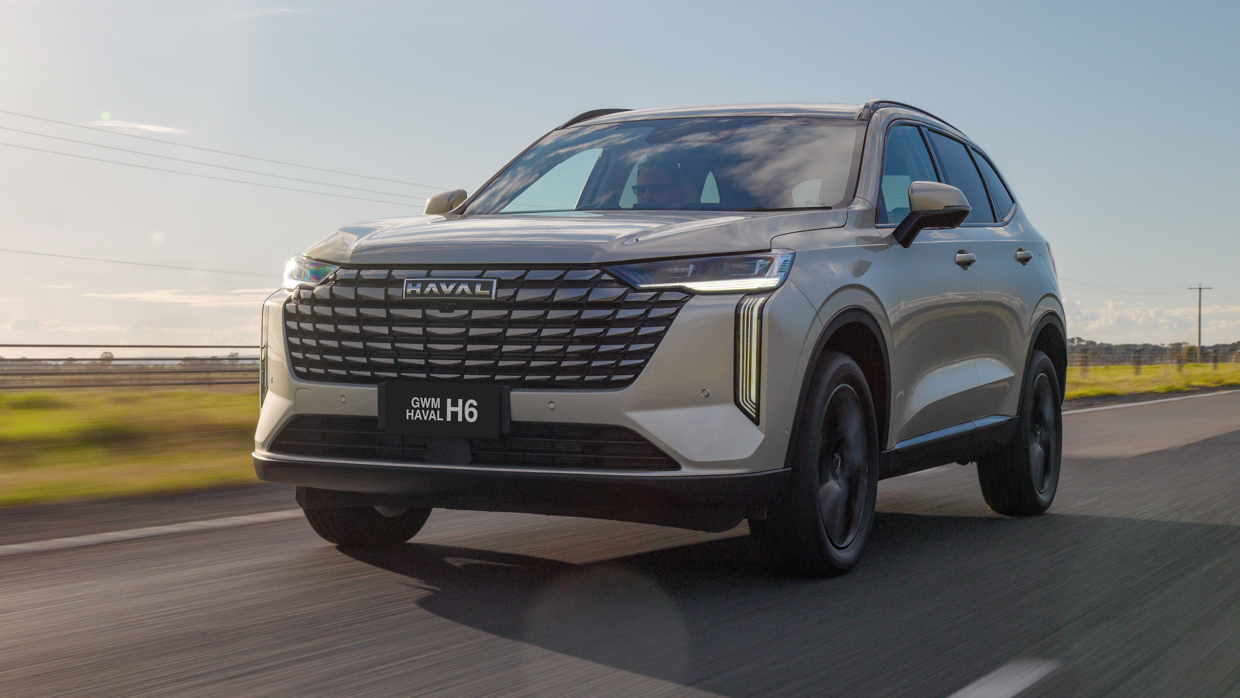
While grip levels remain a touch patchy and body roll is still rather noticeable, the H6 inspires just about double the confidence while tackling a winding country road, while low-speed parking maneouvres are easier to judge and, as a result, feel more natural.
Both handling scenarios were under the microscope, with the GWM team bringing across the same kind of priorities as they had at Holden: easy lightness to drive in urban areas while inspiring confidence for keen drivers that want to increase the pace on a B-road.
As for the ride quality, it’s much better. The big vice of the pre-update H6 was that it was underdamped — a factor that was especially noticeable on the rebound stroke of the shock absorber. After driving across an expansion joint, the pre-update H6 would nearly bottom out, causing a ‘whoomp’ in your stomach that was quite unenjoyable.

Trubiani’s team has pulled apart the H6’s shocks and recalibrated the compression and rebound strokes primarily to dial out the underdamped character and get the H6 closer to the critical damping point where bumps are nicely insulated and rebound is quick and tidy.
And the H6 is indeed closer to that point, with a ride that remains somewhat firm — but controlled and neat — on the country roads we were able to test it out on.
As for the plug-in hybrid powertrain: the PHEV also represents an improvement over the HEV, which we criticised for “laggy acceleration off the line” on account of the amateurish tuning of its hybrid power unit — the bit that decides whether petrol or electricity will be used for a particular throttle application.
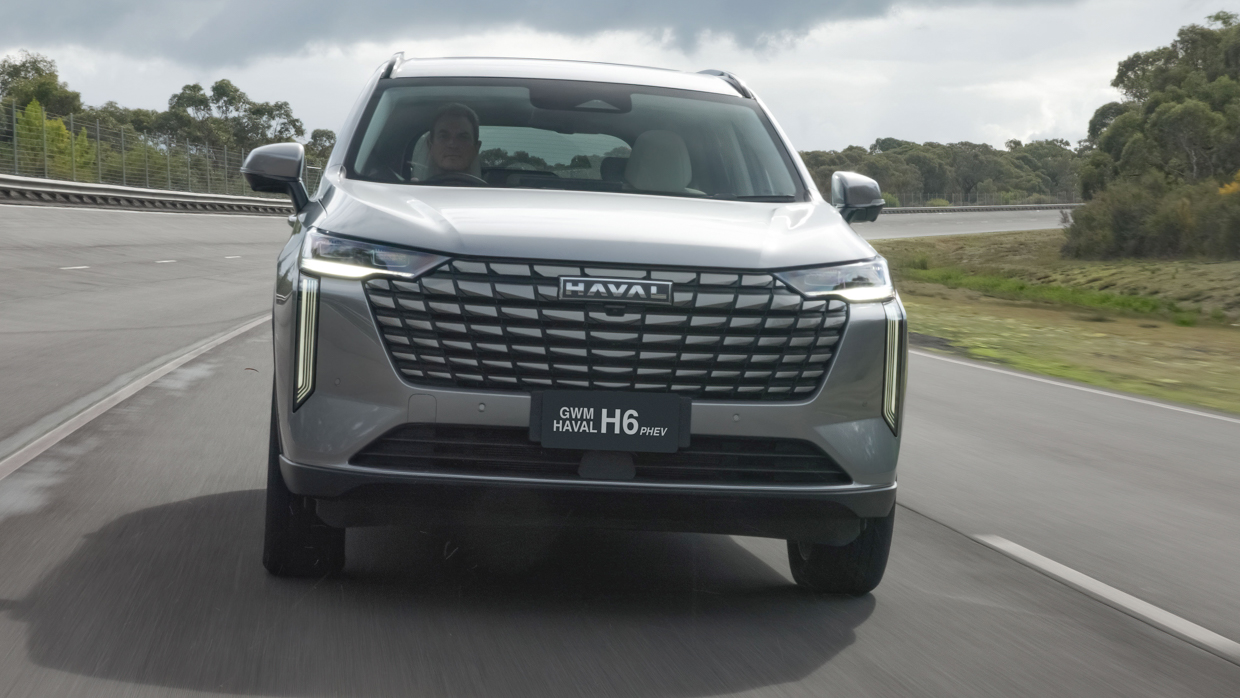
It isn’t clear whether the PHEV’s hybrid ‘brain’ is better or simply that it has more electric brawn up its sleeve to ‘cover’ for the system’s laggardly thinking. The important bit is that step-off lag is basically eliminated, at least when there’s reasonable charge in the battery.
Like many PHEVs, the GWM system appears to keep a greater buffer of battery power in reserve than the regular HEV to avoid its considerable 240kW/540Nm (FWD) or 268kW/760Nm (Hi4 AWD) performance being degraded.
An interesting advantage of the Hi4 AWD version of the PHEV is that it can confidently operate as an EV only when it is charged up, with its dual motors able to feed in 230kW/500Nm without even waking up the petrol engine (itself rated at just 110kW/240Nm).
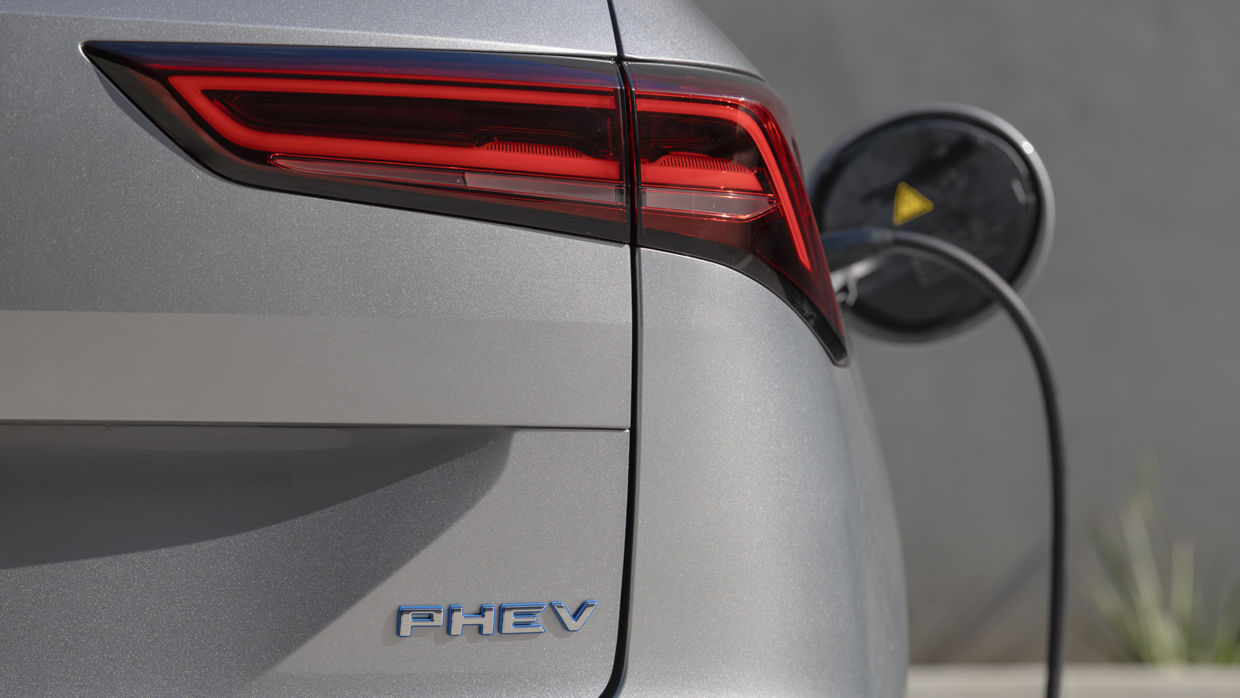
While the FWD version of the PHEV is still quick, it’s the AWD that is the clear H6 powertrain standout. While its overall power and torque figures are shared with the marginally cheaper HEV AWD, the PHEV has the bulk battery capacity to deploy all that power with regularity. We haven’t tested the 4.8 sec 0-100km/h claim, but it certainly feels perky.
On our test drive, we recorded country road EV-mode power consumption of 21.4kWh/100km (from a 19.09kWh LFP battery, for 89km tested range), and dead-battery fuel consumption of 5.8L/100km (948km petrol range), both close to GWM’s claims. No urban test was possible at this stage. Charging the traction battery is possible via AC (6.6kW) and DC (34kW) means.
GWM continues to do a better job than many rivals (particularly other Chinese brands) at limiting safety system sensitivity. The PHEV has no audible attention monitoring and no camera-driven driver attention monitor; while lane-keep assist can still be grabby, it can be permanently deactivated.
How is the H6 PHEV with Australian tune’s interior?
There’s more sophistication to the H6’s new PHEV powertrain — and its Australian ride/handling tune — than there is to the interior, which while serviceable and modern-looking is a little lacking ergonomically.
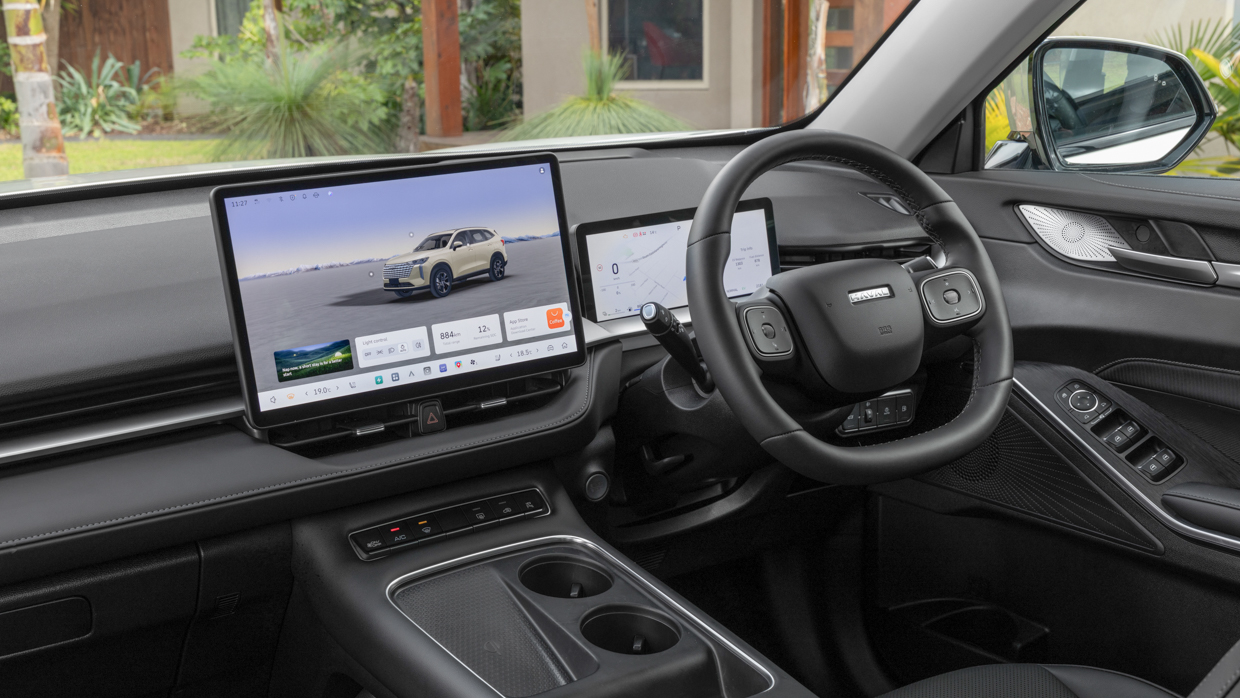
While the H6 deserves credit for remaining one of the most affordable cars in the midsize SUV segment, corners cut to deliver sub-$50,000 pricing across the range grate more when the rest of the car is suddenly very competitive indeed.
We’re talking about things like the lack of tilt adjustment for the driver’s seat across the range, meaning long-legged folk can’t get properly comfy. Or the fact the passenger seat doesn’t have height adjustment. And even little things like the digital instrument cluster lacking the customisation of a Toyota RAV4 — this comes off as basic.

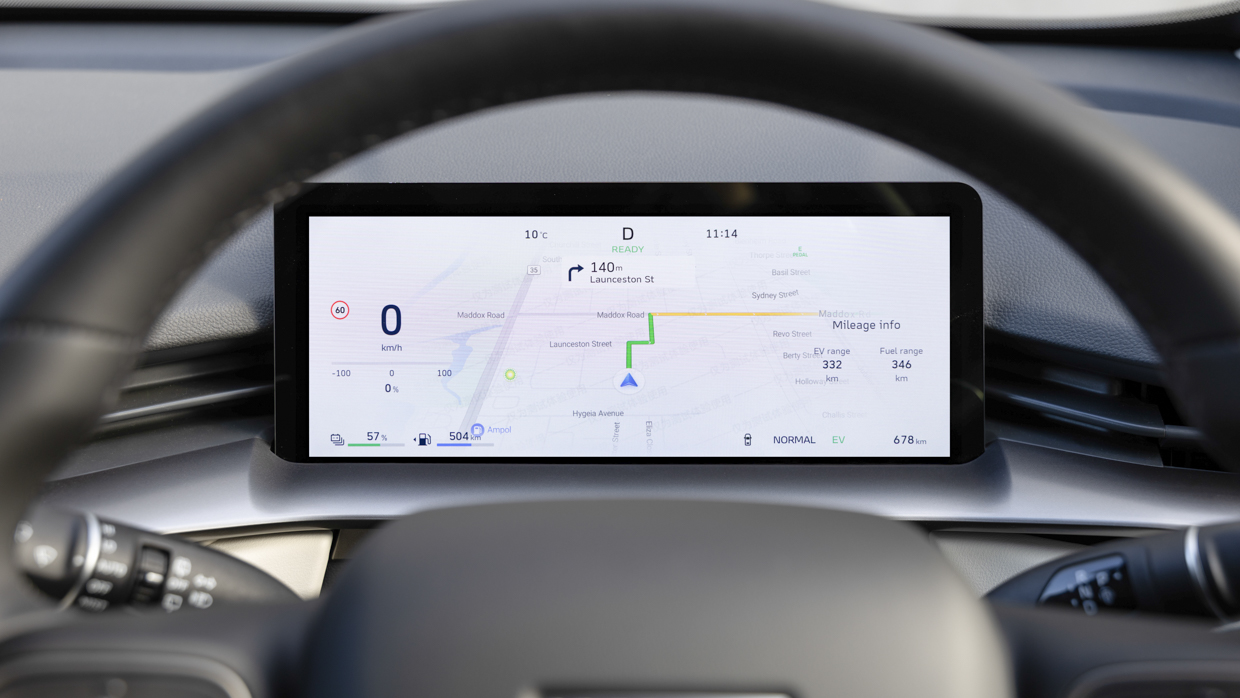
We don’t particularly mind the lack of character inside: like many Chinese cars, the H6’s dashboard could be found in models of many different brands. The aesthetic is dominated by a 14.6-inch rectangular central touchscreen and a 10.0-inch instrument display.
Weirdly, the screens you get differ based on whether you go for petrol/HEV, or for the new PHEV — with the latter picking up a very considerable upgrade in the form of GWM’s new Coffee OS 3 infotainment system (with Australia-specific adjustments).
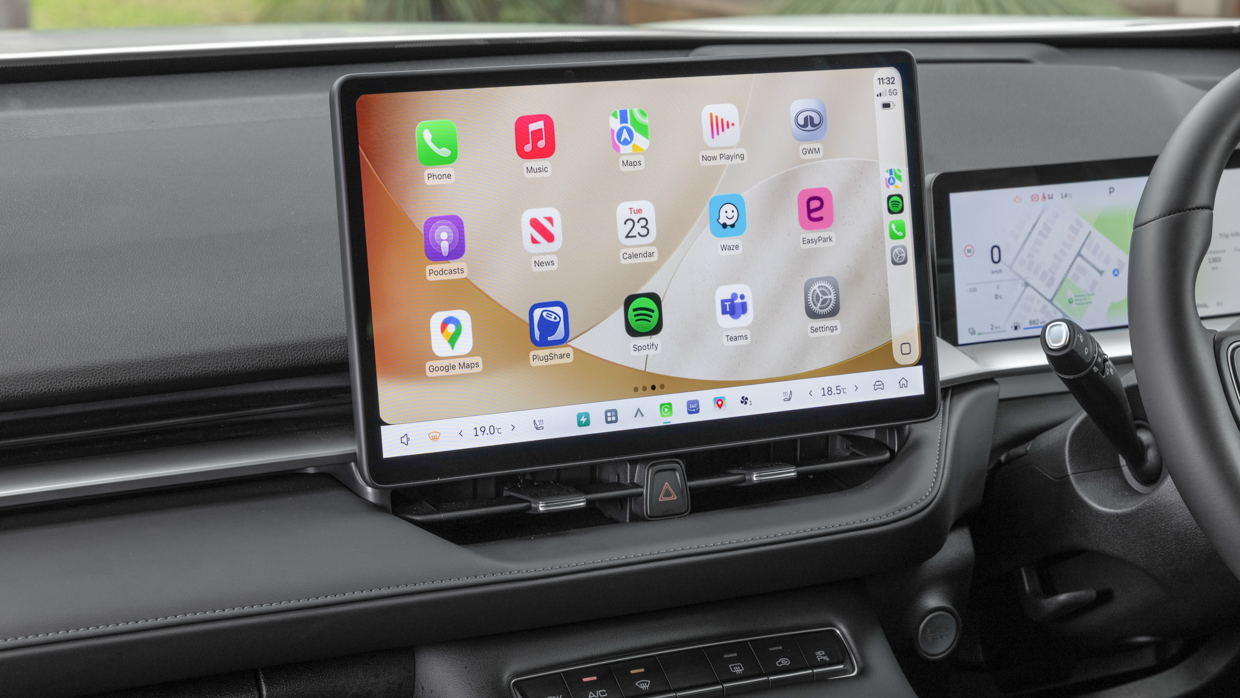
Coffee is a huge leap forward, abandoning the aftermarket look and feel of GWM’s old system in favour of far more processing power, fewer arcane menus, an always-on climate bar, new steering wheel controls, and connected car functionality with conveniences like remote air-con activation and telematics data.
We expect this system will be rolled out to (at least) the regular hybrid in time, but for now, the system is a PHEV-only exclusive and more reason to step up to the plug-in.
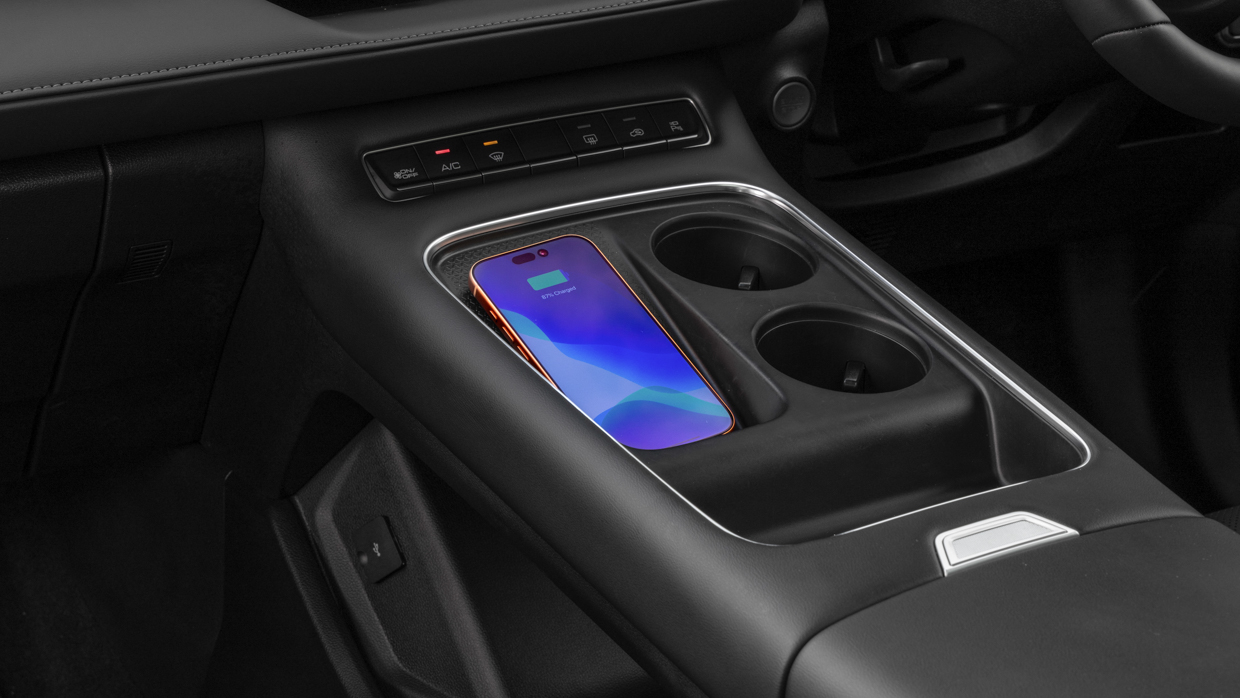

Otherwise, the cabin is passable: the vinyl seat trim feels fake (but is at least ventilated for Aussie summers in the Ultra grade) while the ‘gummy’ material that covers the facelift H6’s centre ‘bridge’ is slightly suspect but at least it absorbs light and sound more than hard plastic.
The back seat shines with enormous legroom and solid headroom, plus standard air vents across the range — and the seat base in row two is more supportive than the one in the front.
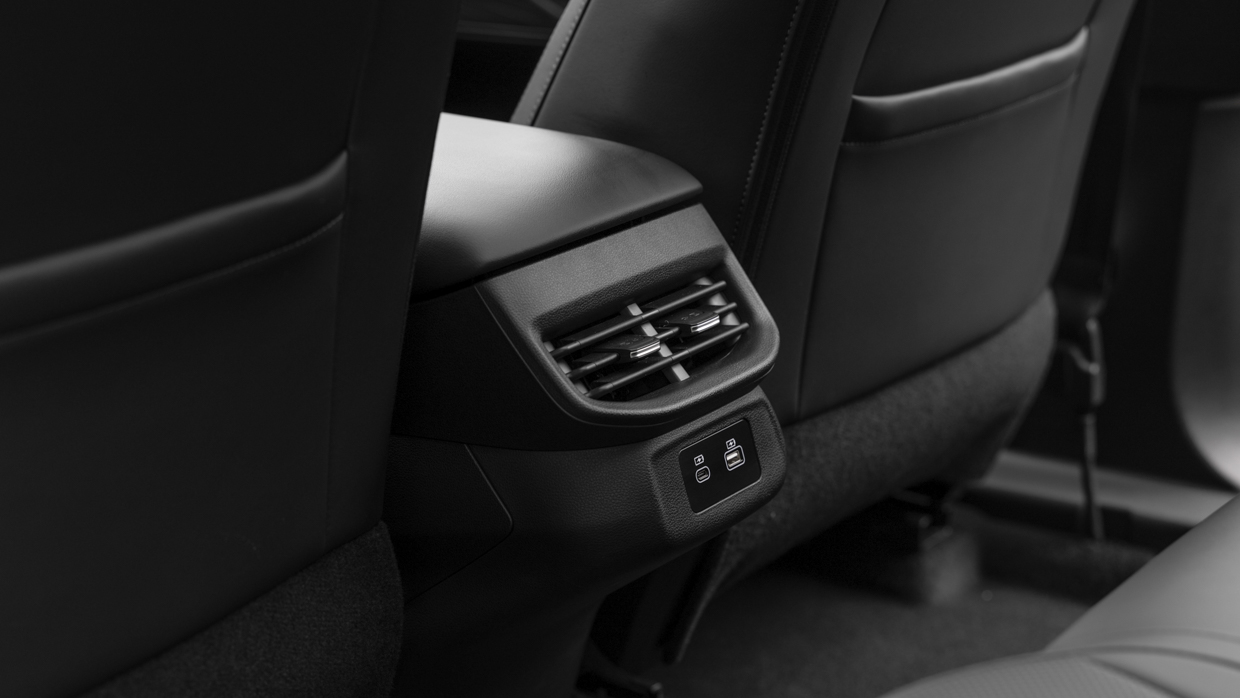

Boot space is claimed to be 560 litres across the range in five-seat mode and 1445 litres with the second row folded flat. A power tailgate is standard on all hybrid and PHEV trims.
The final verdict
There are now a few clear takeaways about the Haval H6 lineup in Australia that should help to inform your purchase decision.
The first is that, with the forthcoming Australian ride and handling tune, the H6 deserves to be on your test-drive list if you’re after a midsize SUV. Just keep in mind: only the HEV and PHEV versions score the new suspension and steering adjustments, for now.

So how do you pick between the HEV and the PHEV? Well, only the plug-in hybrid has the battery capacity to consistently make the most of its electric outputs. It avoids the lag of the regular hybrid by being able to deploy electric poke much more of the time.
Compared to a Toyota RAV4 hybrid powertrain, the H6 HEV’s calibration is decidedly average — the H6 PHEV feels considerably slicker and smarter.
We acknowledge HEV to PHEV is a steep-ish $4000 jump in 2WD form, but the $1500 leap from HEV AWD to PHEV AWD should be a no-brainer — it’s clear the PHEV Hi4 AWD is peak Haval H6.

Blend in the convincing local ride and handling changes with the slick PHEV powertrain, and it seems likely this is the best GWM ever sold in Australia — and a very convincing midsize SUV.



